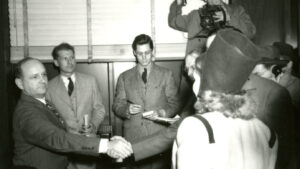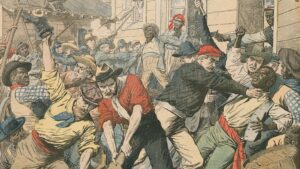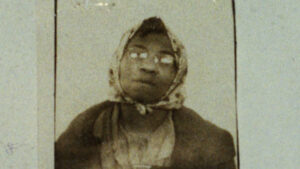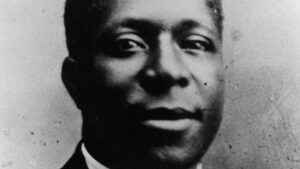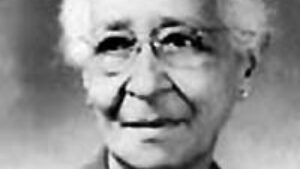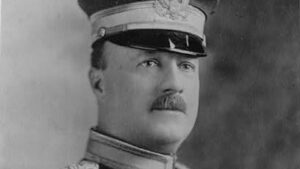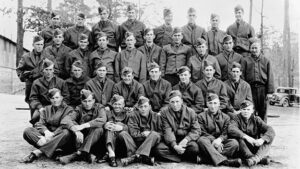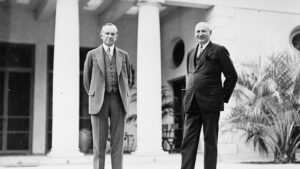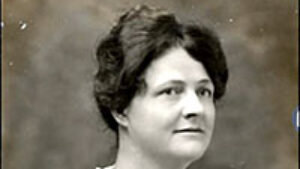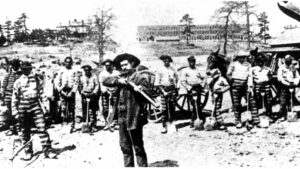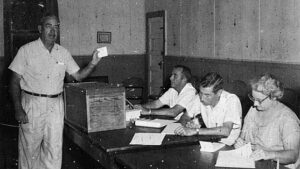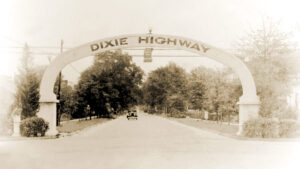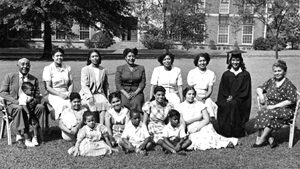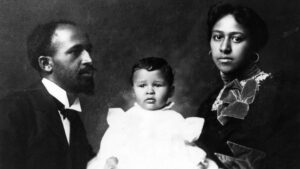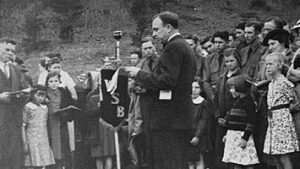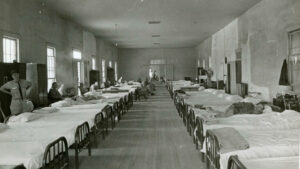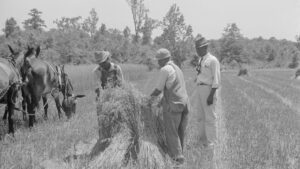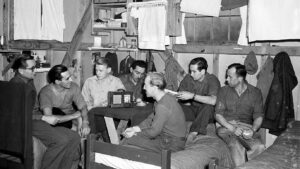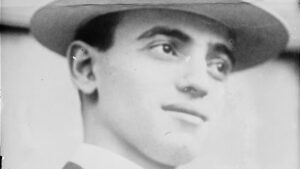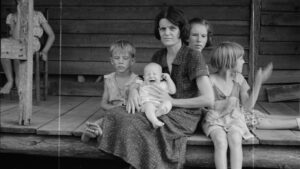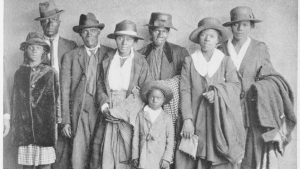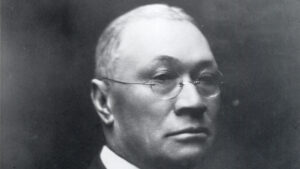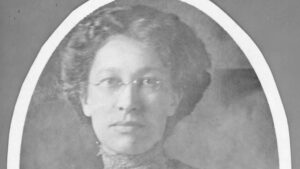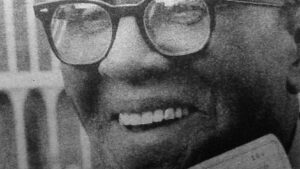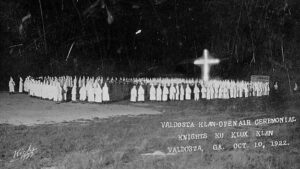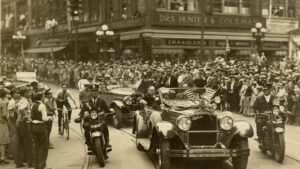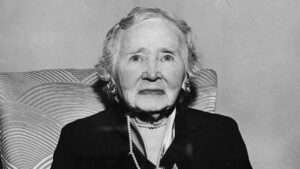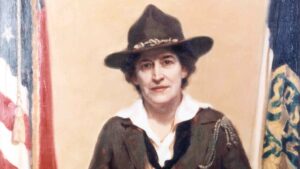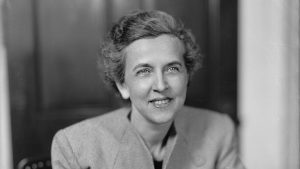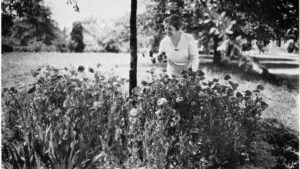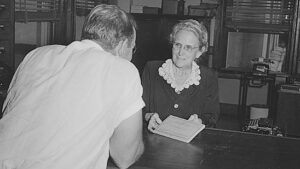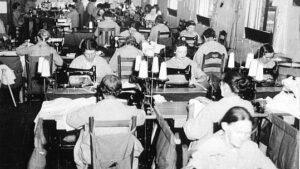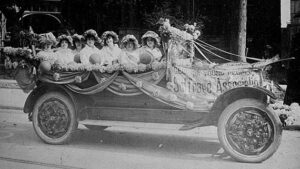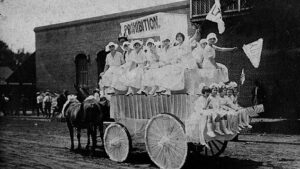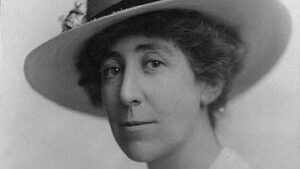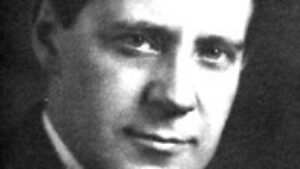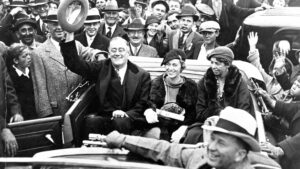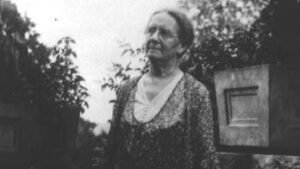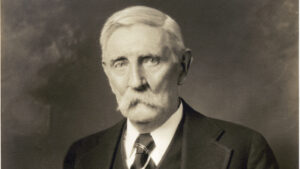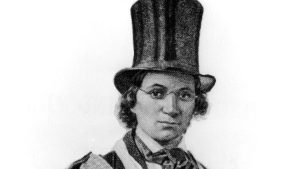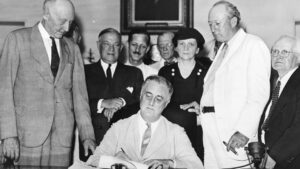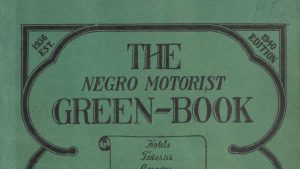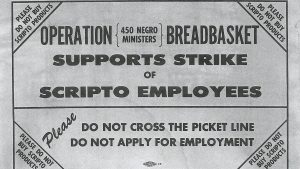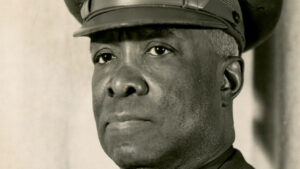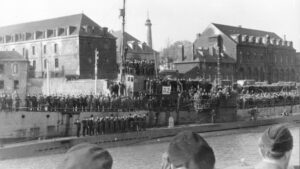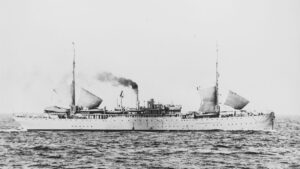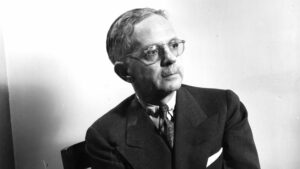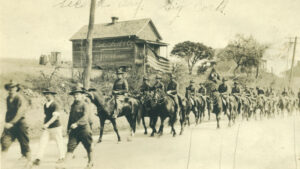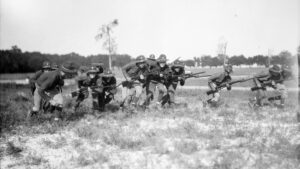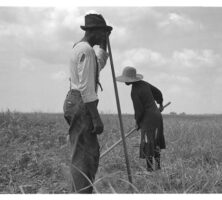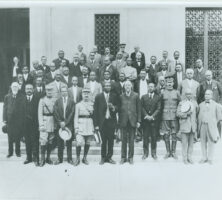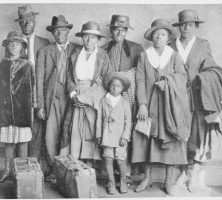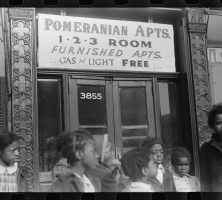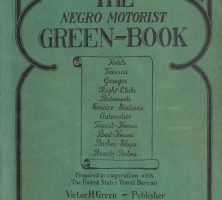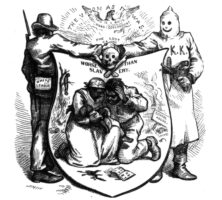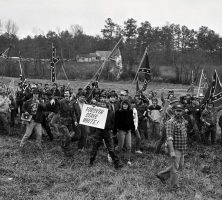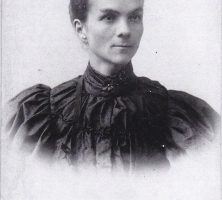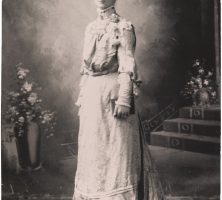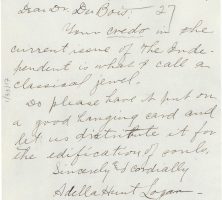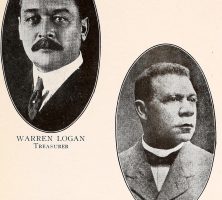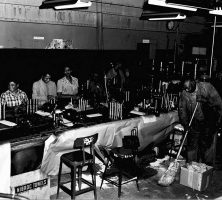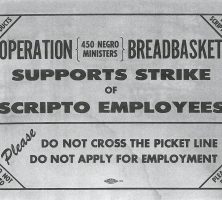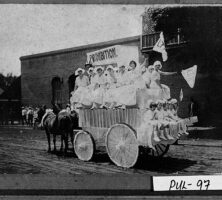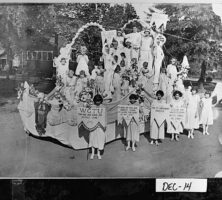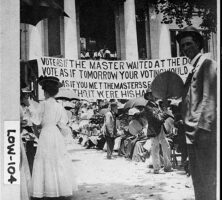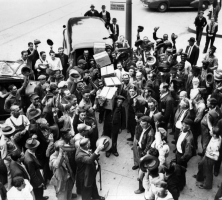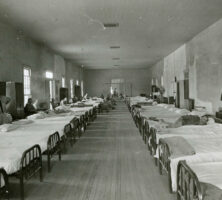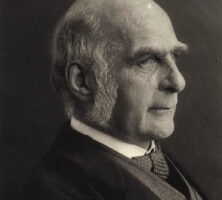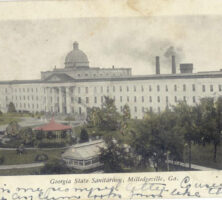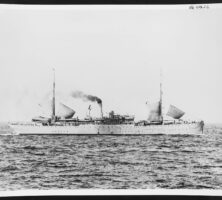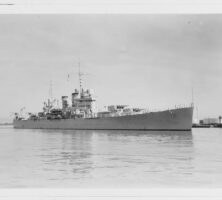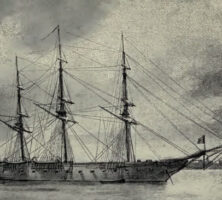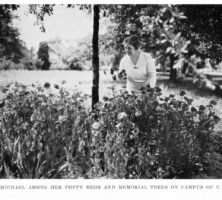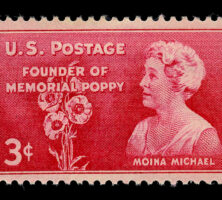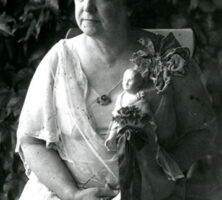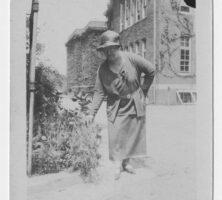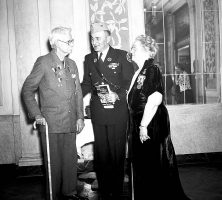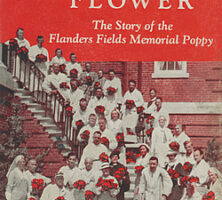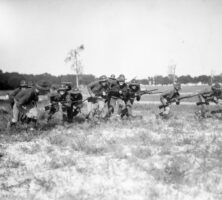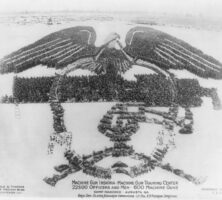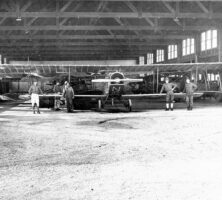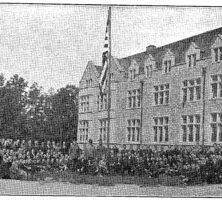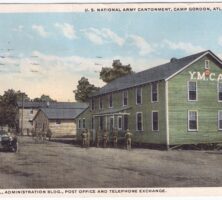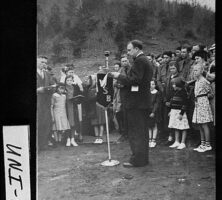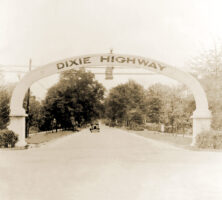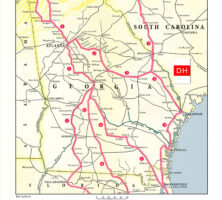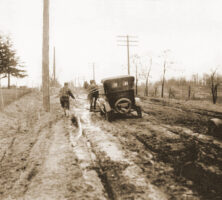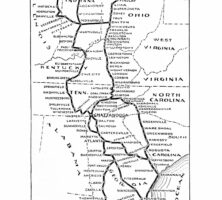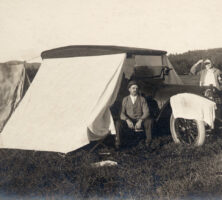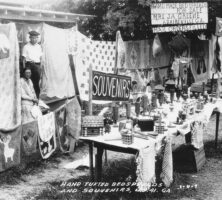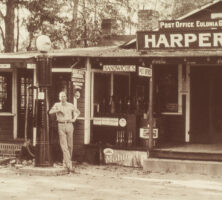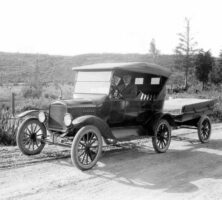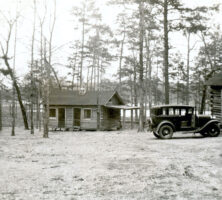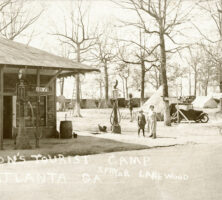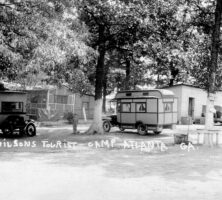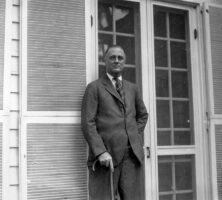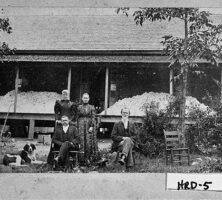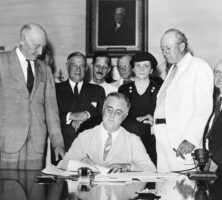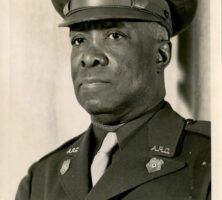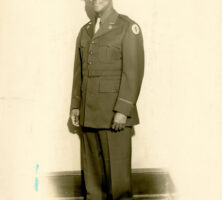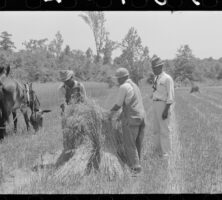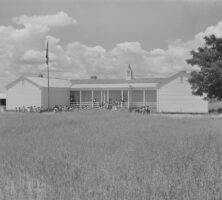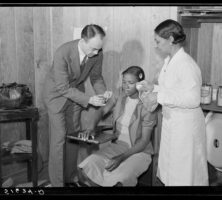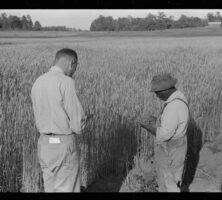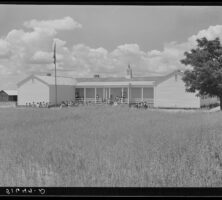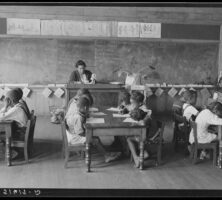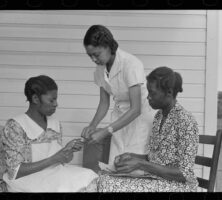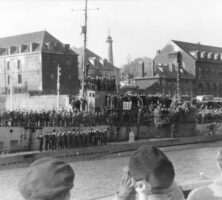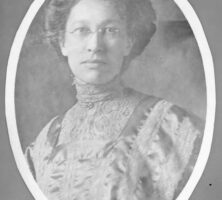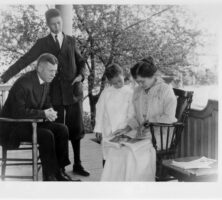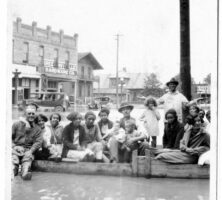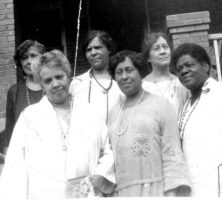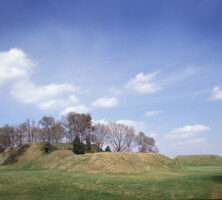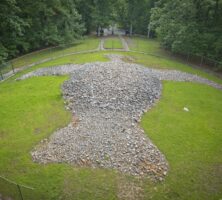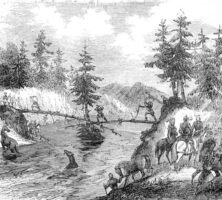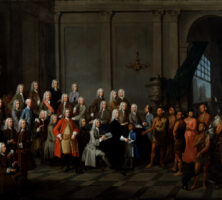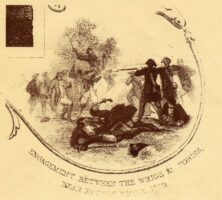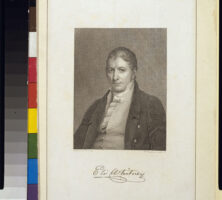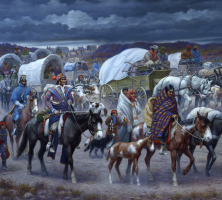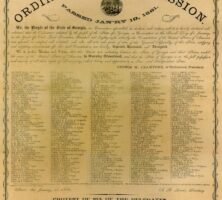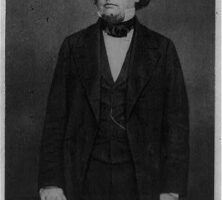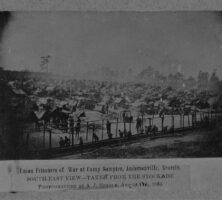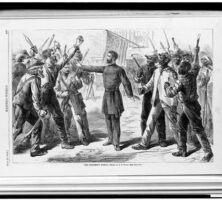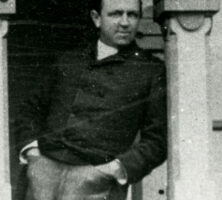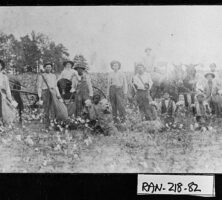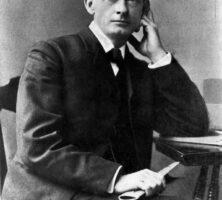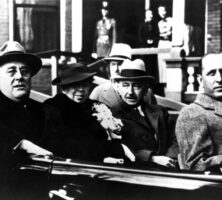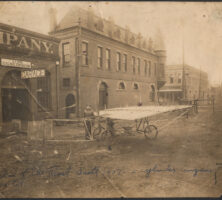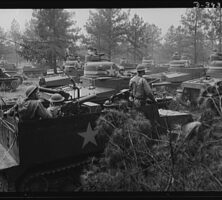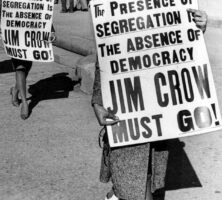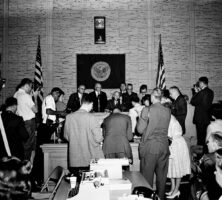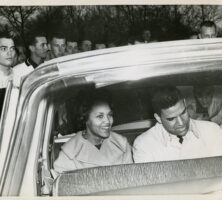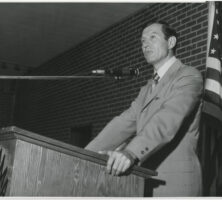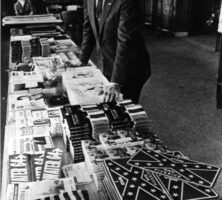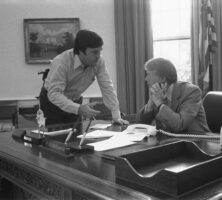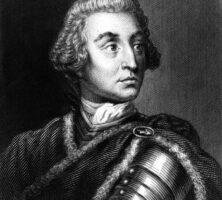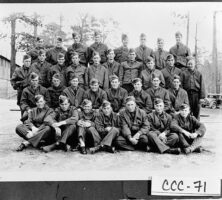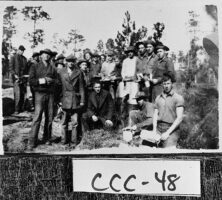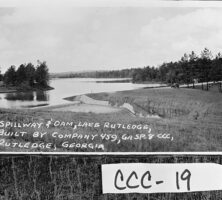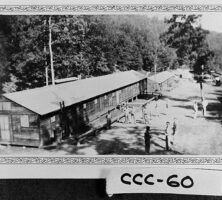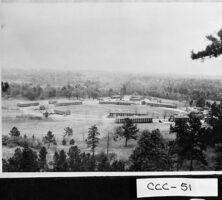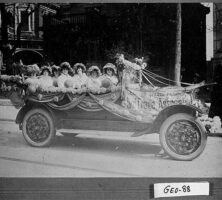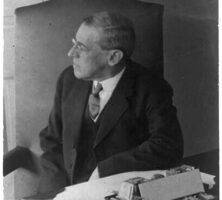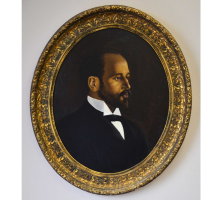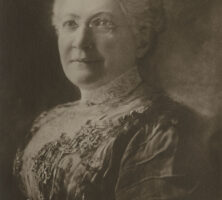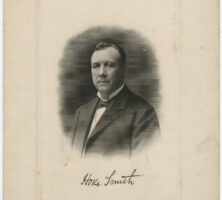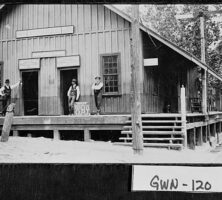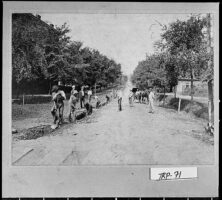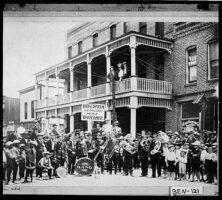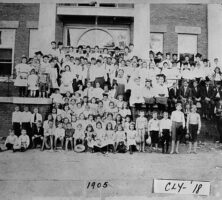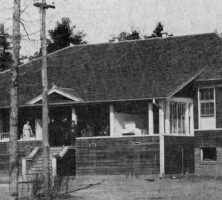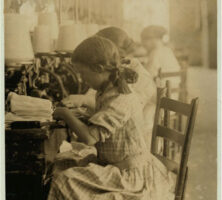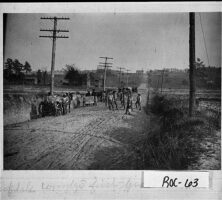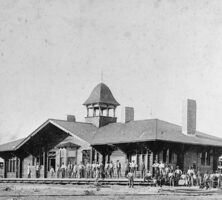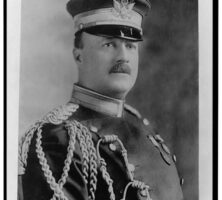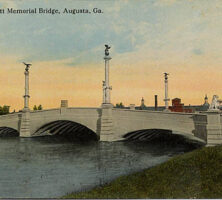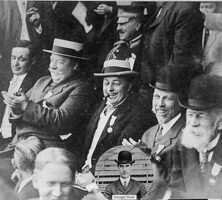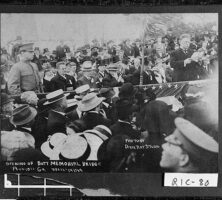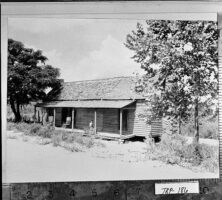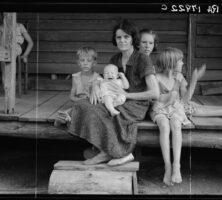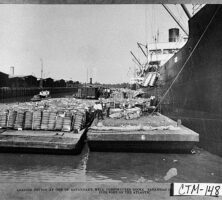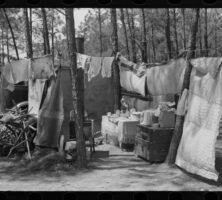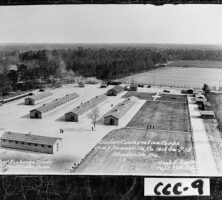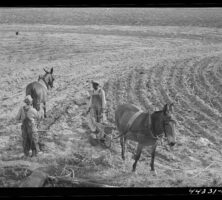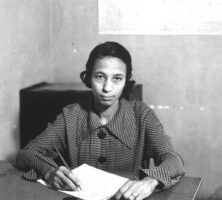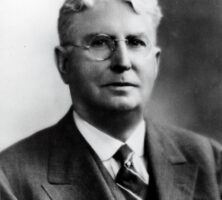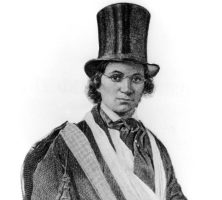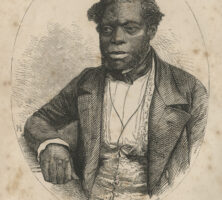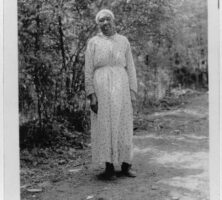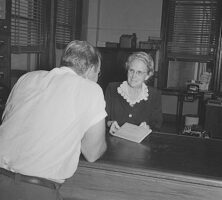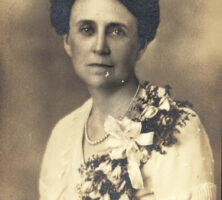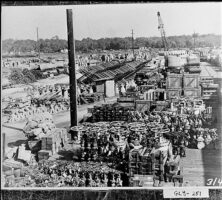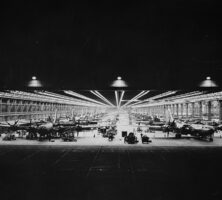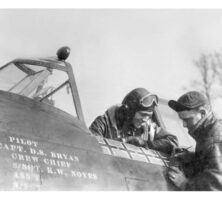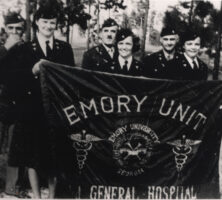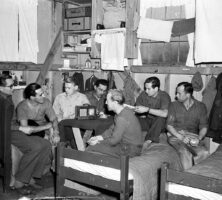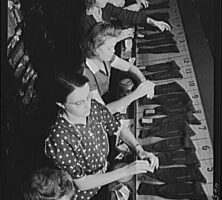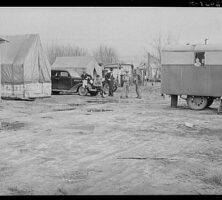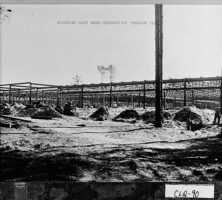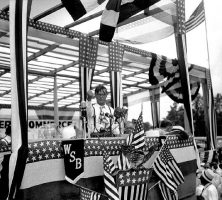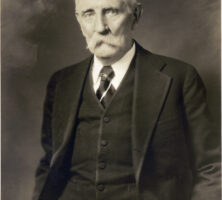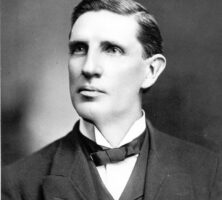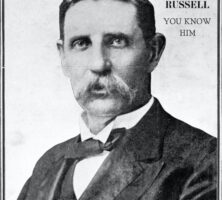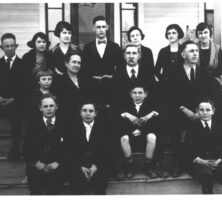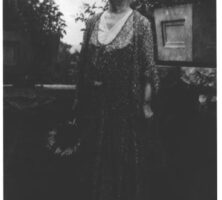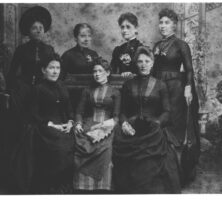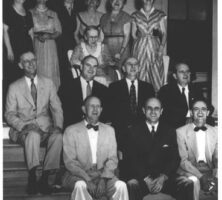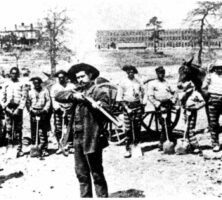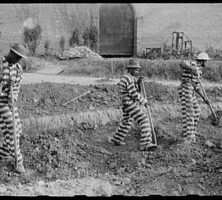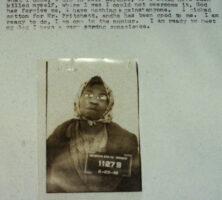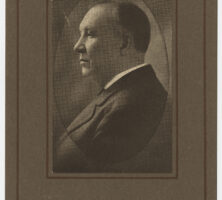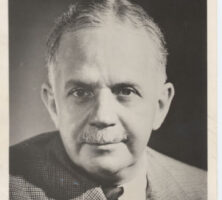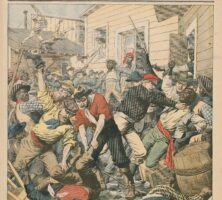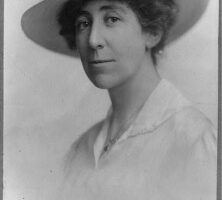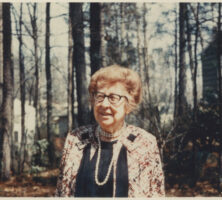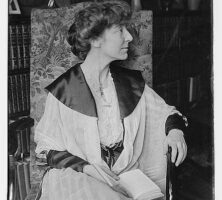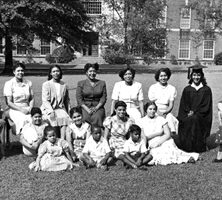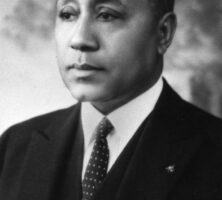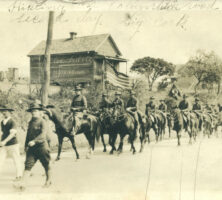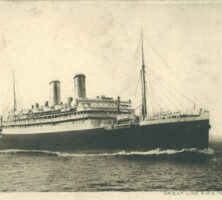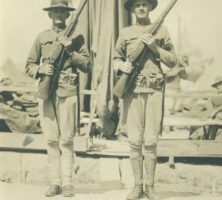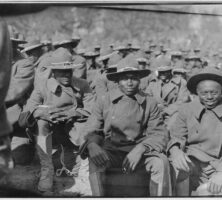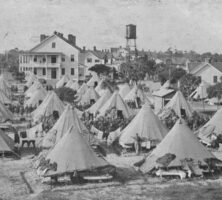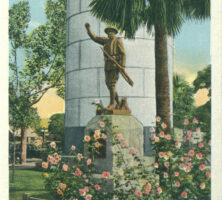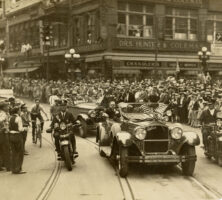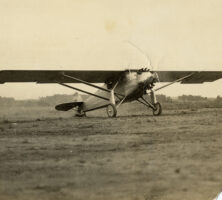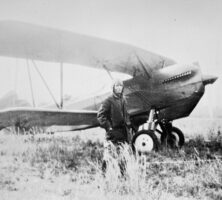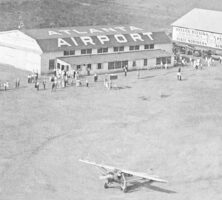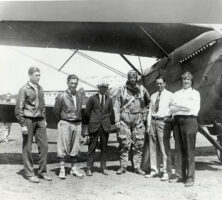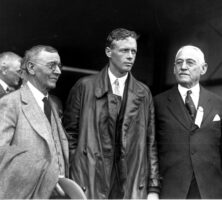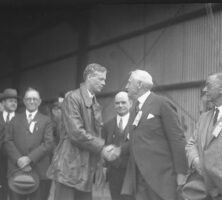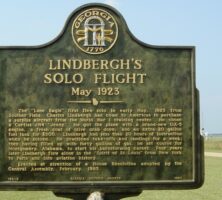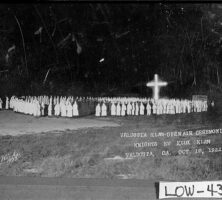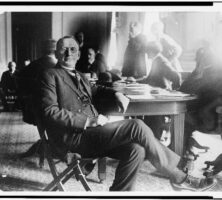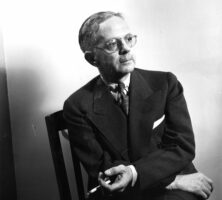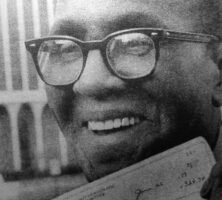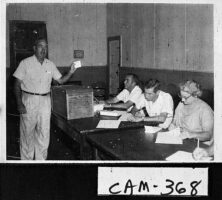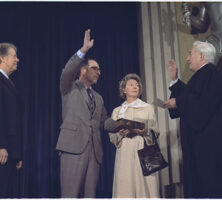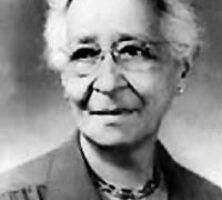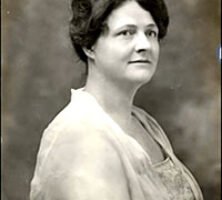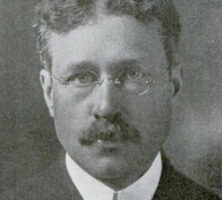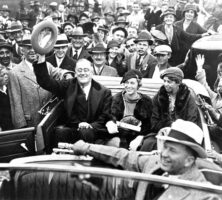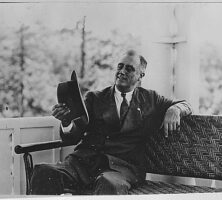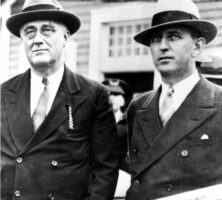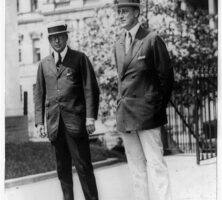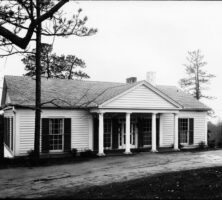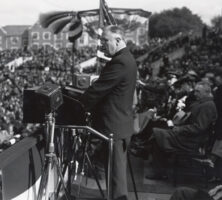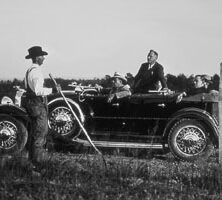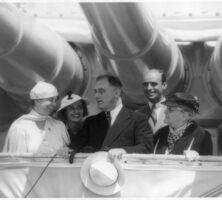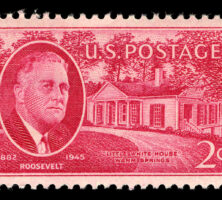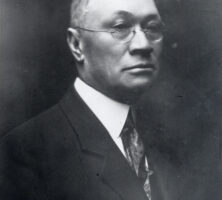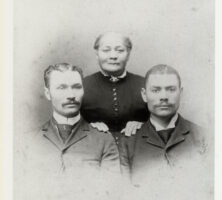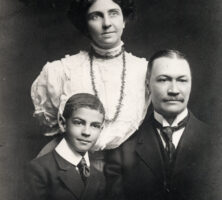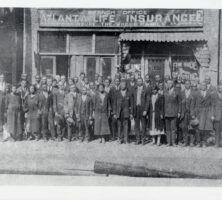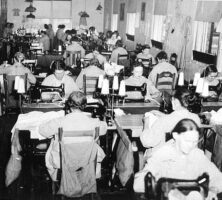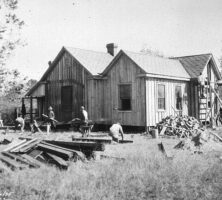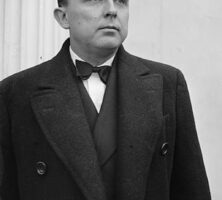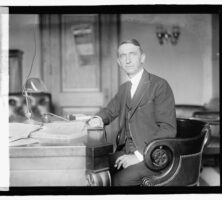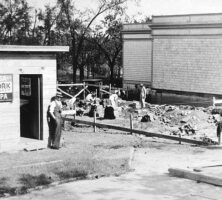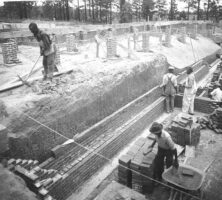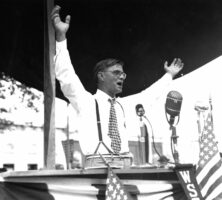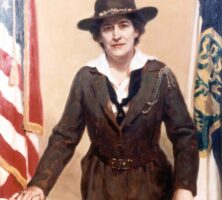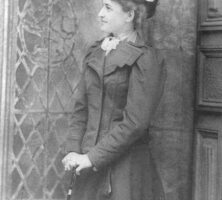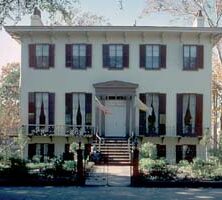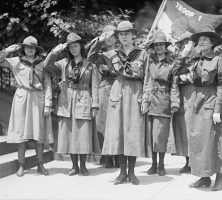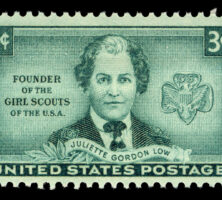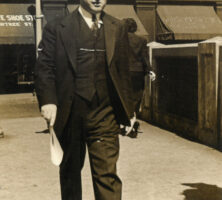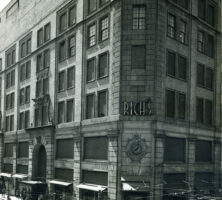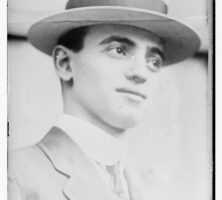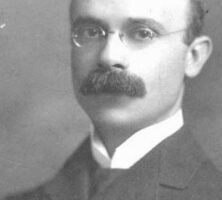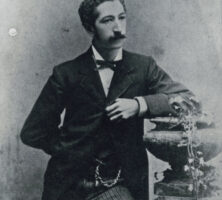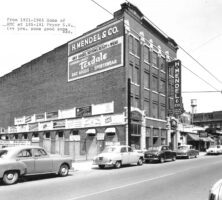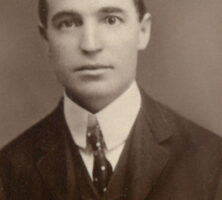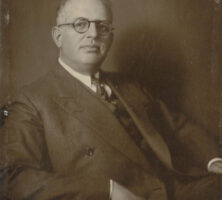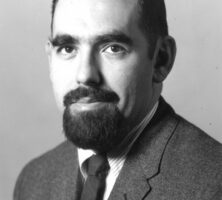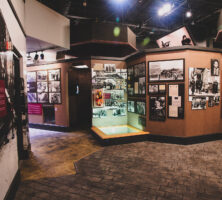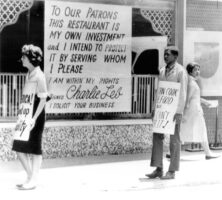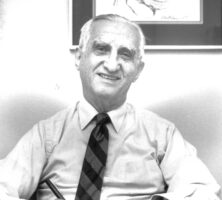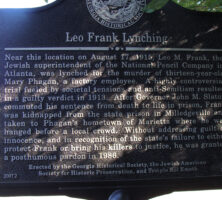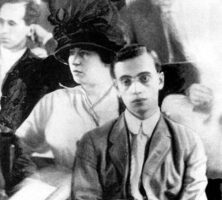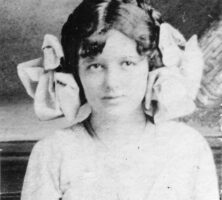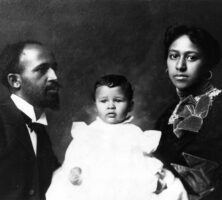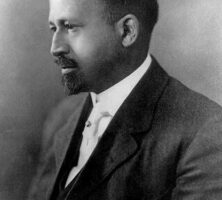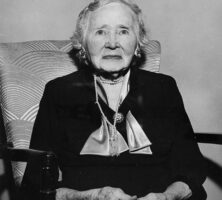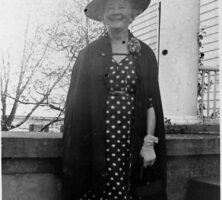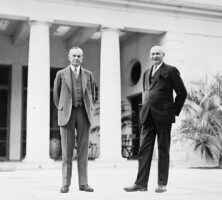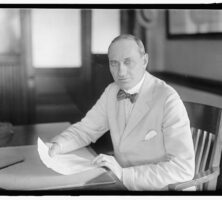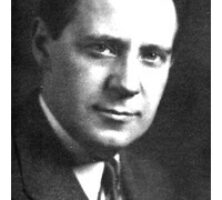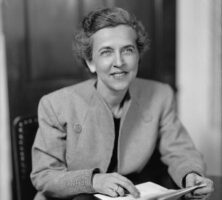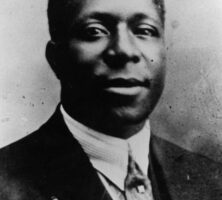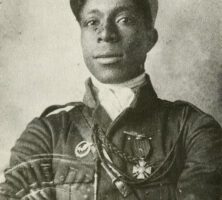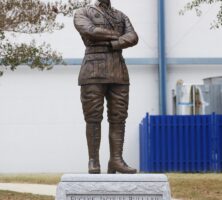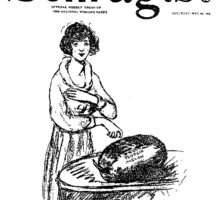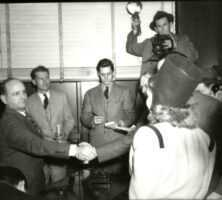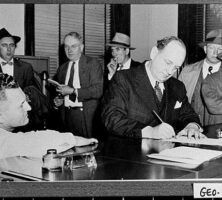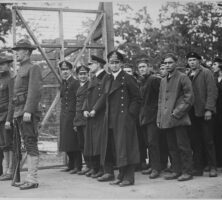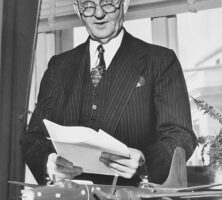The New Georgia Encyclopedia is supported by funding from A More Perfect Union, a special initiative of the National Endowment for the Humanities.
Cotton sharecroppers in Greene County, 1937. The sociologist Arthur F. Raper studied the county in the 1930s and found that soil depletion, low cotton prices, and boll weevil attacks were causing a massive outmigration of farmers.
Courtesy of Library of Congress, Prints and Photographs Division, Photograph by Dorothea Lange, Farm Security Administration - Office of War Information Photograph Collection, #LC-USF34-T01-017335-C.
The New Georgia Encyclopedia does not hold the copyright for this media resource and can neither grant nor deny permission to republish or reproduce the image online or in print. All requests for permission to publish or reproduce the resource must be submitted to the rights holder.
Robert S. Abbott, a Georgia native, was a prominent journalist who founded the Chicago Defender in 1905. He is pictured (second row, fifth from right) in June 1918 at a meeting of Black leaders in Washington, D.C. Prominent historian and educator W. E. B. Du Bois stands in the first row, fourth from the right.
Courtesy of Special Collections and University Archives, University of Massachusetts Amherst Libraries
The New Georgia Encyclopedia does not hold the copyright for this media resource and can neither grant nor deny permission to republish or reproduce the image online or in print. All requests for permission to publish or reproduce the resource must be submitted to the rights holder.
Over the course six decades, roughly 6 million Black southerners moved from the South to the North, Midwest, and West. Driven by the availability of jobs outside the South, as well as the desire to escape racial violence within it, migrants moved primarily from rural, agricultural areas like Georgia’s Black Belt to cities such as Detroit, New York, Los Angeles, and Chicago.
From The New York Public Library, The Negro in Chicago: A Study of Race Relations and a Race Riot, by the Chicago Commission on Race Relations.
The New Georgia Encyclopedia does not hold the copyright for this media resource and can neither grant nor deny permission to republish or reproduce the image online or in print. All requests for permission to publish or reproduce the resource must be submitted to the rights holder.
Black southerners left rural, agricultural areas like Georgia’s Black Belt for cities such as Detroit, New York, Chicago, and Los Angeles. Migrants found their new settings to be an improvement but also full of obstacles. White flight and discriminatory housing policies funneled African Americans into poorer neighborhoods and public housing complexes.
Courtesy of Library of Congress, Prints and Photographs Division, Farm Security Administration/Office of War Information Black-and-White Negatives.
The New Georgia Encyclopedia does not hold the copyright for this media resource and can neither grant nor deny permission to republish or reproduce the image online or in print. All requests for permission to publish or reproduce the resource must be submitted to the rights holder.
The Negro Motorist Green-Book, also known as the Negro Traveller's Green-Book, was an essential guide for Black travelers between 1936 and 1966. This yearly publication, created by postal employee Victor Hugo Green, helped readers avoid sundown towns and locate safe lodging, gas stops, and eateries.
From Wikimedia
The New Georgia Encyclopedia does not hold the copyright for this media resource and can neither grant nor deny permission to republish or reproduce the image online or in print. All requests for permission to publish or reproduce the resource must be submitted to the rights holder.
Most Ku Klux Klan action was designed to intimidate Black voters and white supporters of the Republican Party. Founded in Tennessee in 1866, the Klan was particularly active in Georgia from 1868 to the early 1870s.
From Harper's Weekly
The New Georgia Encyclopedia does not hold the copyright for this media resource and can neither grant nor deny permission to republish or reproduce the image online or in print. All requests for permission to publish or reproduce the resource must be submitted to the rights holder.
White supremacists picketing at the first Brotherhood March on January 17, 1987, in Forsyth County.
Courtesy of Atlanta Journal-Constitution, Atlanta Journal-Constitution Photographic Archive, #AJCNS1987-01-17l.
The New Georgia Encyclopedia does not hold the copyright for this media resource and can neither grant nor deny permission to republish or reproduce the image online or in print. All requests for permission to publish or reproduce the resource must be submitted to the Atlanta Journal-Constitution.
Educator and suffragist Adella Hunt Logan received an honorary master's degree from Atlanta University in 1901. The degree was "honorary" because the school was not yet accredited to grant graduate degrees.
From Adele Logan Alexander's personal collection
The New Georgia Encyclopedia does not hold the copyright for this media resource and can neither grant nor deny permission to republish or reproduce the image online or in print. All requests for permission to publish or reproduce the resource must be submitted to the rights holder.
Adella Hunt Logan is pictured in her wedding dress in Atlanta. She married Tuskegee Institute treasurer Warren Logan in 1888.
From Wikimedia
The New Georgia Encyclopedia does not hold the copyright for this media resource and can neither grant nor deny permission to republish or reproduce the image online or in print. All requests for permission to publish or reproduce the resource must be submitted to the rights holder.
After accepting a teaching position at the Tuskegee Institute in 1883, Adella Hunt Logan forged enduring relationships with fellow educators and civil rights leaders. Among her new acquaintances was NAACP cofounder W. E. B. Du Bois, with whom she shared a lifelong correspondence.
Courtesy of Special Collections and University Archives, University of Massachusetts Amherst Libraries
The New Georgia Encyclopedia does not hold the copyright for this media resource and can neither grant nor deny permission to republish or reproduce the image online or in print. All requests for permission to publish or reproduce the resource must be submitted to the rights holder.
Tuskegee Institute founder Booker T. Washington and school treasurer Warren Logan are featured in the Lincoln Jubilee Album, shortly after Washington's death in 1915.
Image from Wikimedia, Lincoln Financial Foundation Collection.
The New Georgia Encyclopedia does not hold the copyright for this media resource and can neither grant nor deny permission to republish or reproduce the image online or in print. All requests for permission to publish or reproduce the resource must be submitted to the rights holder.
Between 1931 and 1977, Black female employees at the Scripto factory in Atlanta organized against unfair wages and a discriminatory work environment. Their activism was a precursor to the civil rights movement.
Courtesy of Special Collections & Archives, Georgia State University Library, Lane Brothers Commercial Photographers Photographic Collection, #LBCB095-022a.
The New Georgia Encyclopedia does not hold the copyright for this media resource and can neither grant nor deny permission to republish or reproduce the image online or in print. Requests for permission to publish or reproduce the resource should be submitted to Special Collections and Archives at Georgia State University.
Black women made up more than 80 percent of the workforce at Scripto's factory in Atlanta. This 1958 advertisement depicts ballpoint pens, one of the company's most popular products.
Image from James Vaughan
The New Georgia Encyclopedia does not hold the copyright for this media resource and can neither grant nor deny permission to republish or reproduce the image online or in print. All requests for permission to publish or reproduce the resource must be submitted to the rights holder.
Cigarette lighters, such as the popular Compact Vu-Lighter shown here, were one of Scripto Inc.'s defining products, along with pens and mechanical pencils.
Image from Joe Haupt
The New Georgia Encyclopedia does not hold the copyright for this media resource and can neither grant nor deny permission to republish or reproduce the image online or in print. All requests for permission to publish or reproduce the resource must be submitted to the rights holder.
Operation Breadbasket was created in 1962 as a branch of the Southern Christian Leadership Conference (SCLC). A minister-led program, Operation Breadbasket worked to improve economic conditions in the Black community through boycotts and organized support.
Courtesy of Stuart A. Rose Manuscript, Archives, and Rare Book Library, Emory University, Southern Christian Leadership Records.
The New Georgia Encyclopedia does not hold the copyright for this media resource and can neither grant nor deny permission to republish or reproduce the image online or in print. For more information about this resource, contact the Stuart A. Rose Manuscript, Archives, and Rare Book Library at Emory University.
Young women and children ride on a parade float promoting prohibition in Hawkinsville (Pulaski County), circa 1919.
Courtesy of Georgia Archives, Vanishing Georgia, #
pul097a.
The New Georgia Encyclopedia does not hold the copyright for this media resource and can neither grant nor deny permission to republish or reproduce the image online or in print. Requests for permission to publish or reproduce the resource should be submitted to the Georgia Archives.
Women's Christian Temperance Movement (WTCU) members participate in the Decatur County centennial parade in Bainbridge, 1923. The WCTU formed its first Georgia chapter in 1880. Largely due to their efforts, Georgia passed a local option law in 1885.
Courtesy of Georgia Archives, Vanishing Georgia, #
dec014.
The New Georgia Encyclopedia does not hold the copyright for this media resource and can neither grant nor deny permission to republish or reproduce the image online or in print. Requests for permission to publish or reproduce the resource should be submitted to the Georgia Archives.
A crowd gathered in front of the Lowndes County courthouse in Valdosta for a prohibition vote in 1907. That year, Georgia became the first state in the South to pass a statewide ban on the production, transportation, and sale of alcohol.
Courtesy of Georgia Archives, Vanishing Georgia, #
low104.
The New Georgia Encyclopedia does not hold the copyright for this media resource and can neither grant nor deny permission to republish or reproduce the image online or in print. Requests for permission to publish or reproduce the resource should be submitted to the Georgia Archives.
A crowd in Marietta celebrates the end of prohibition. In 1935 the Georgia legislature approved the Alcoholic Beverage Control Act, which called for a statewide referendum on the issue of repeal and tasked the State Revenue Commission with drafting new regulations to govern the sale and distribution of alcohol.
Courtesy of Special Collections & Archives, Georgia State University Library, Atlanta Journal-Constitution Photographic Archive.
The New Georgia Encyclopedia does not hold the copyright for this media resource and can neither grant nor deny permission to republish or reproduce the image online or in print. Requests for permission to publish or reproduce the resource should be submitted to Special Collections and Archives at Georgia State University.
A sleeping ward at Milledgeville State Hospital for the Insane, circa 1940. Authorities at the hospital practiced compulsory sterilization of patients throughout the 1940s and 1950s. Following an award-winning 1959 report by Atlanta Constitution Jack Nelson, the number of operations dropped dramatically before finally ceasing in 1963.
Courtesy of Special Collections & Archives, Georgia State University Library, Atlanta Journal-Constitution Photographic Archive .
The New Georgia Encyclopedia does not hold the copyright for this media resource and can neither grant nor deny permission to republish or reproduce the image online or in print. Requests for permission to publish or reproduce the resource should be submitted to Special Collections and Archives at Georgia State University.
Francis Galton was an English statistician whose theories on heredity lead him to develop the field of eugenics. During the early twentieth century, Galton's ideas gained support among scientific and medical professionals, politicians, and Progressive-era reform groups.
Image from Eveleen Myers
The New Georgia Encyclopedia does not hold the copyright for this media resource and can neither grant nor deny permission to republish or reproduce the image online or in print. All requests for permission to publish or reproduce the resource must be submitted to the rights holder.
This tinted postcard of the Georgia State Sanitarium (later Central State Hospital) depicts the grounds of the institution circa 1905. During this time the hospital was under the leadership of Theophilus O. Powell, who implemented more precise methods of diagnosis.
Courtesy of Melinda Smith Mullikin, New Georgia Encyclopedia
The New Georgia Encyclopedia does not hold the copyright for this media resource and can neither grant nor deny permission to republish or reproduce the image online or in print. All requests for permission to publish or reproduce the resource must be submitted to the rights holder.
The fourth USS Savannah (CL-42) engaged in Atlantic and Meditteranean operations during World War II (1941-45), most notably Operation Torch, the allied invasion of North Africa.
Photograph by Naval History and Heritage Command
The New Georgia Encyclopedia does not hold the copyright for this media resource and can neither grant nor deny permission to republish or reproduce the image online or in print. All requests for permission to publish or reproduce the resource must be submitted to the rights holder.
The second USS Savannah completed naval operations in the Mexican and Civil Wars.
From Old Naval Days: Sketches From the Life of Rear Admiral William Radford, U. S. N. by Sophie Radford De Meissner, Wikimedia
The New Georgia Encyclopedia does not hold the copyright for this media resource and can neither grant nor deny permission to republish or reproduce the image online or in print. All requests for permission to publish or reproduce the resource must be submitted to the rights holder.
The third USS Savannah (AS-8) served as a submarine tender during World War I (1917-18).
Photograph by Naval History and Heritage Command
The New Georgia Encyclopedia does not hold the copyright for this media resource and can neither grant nor deny permission to republish or reproduce the image online or in print. All requests for permission to publish or reproduce the resource must be submitted to the rights holder.
The New Georgia Encyclopedia does not hold the copyright for this media resource and can neither grant nor deny permission to republish or reproduce the image online or in print. All requests for permission to publish or reproduce the resource must be submitted to the rights holder.
Moina Michael plants poppies on the University of Georgia campus. As a result of her efforts, red poppies became a symbol for military sacrifice around the world.
Photograph from UGA Today
The New Georgia Encyclopedia does not hold the copyright for this media resource and can neither grant nor deny permission to republish or reproduce the image online or in print. All requests for permission to publish or reproduce the resource must be submitted to the rights holder.
A commemorative stamp honoring Moina Belle Michael, a Walton County native and originator of the red memorial poppy, was first issued in November 1948. After World War I, paper poppies were sold and worn on Remembrance Day (Armistice Day), held on the second Sunday in November in Britain, to fund soldier rehabilitation.
Courtesy of Smithsonian National Postal Museum
The New Georgia Encyclopedia does not hold the copyright for this media resource and can neither grant nor deny permission to republish or reproduce the image online or in print. All requests for permission to publish or reproduce the resource must be submitted to the rights holder.
This envelope commemorates Moina Belle Michael, longtime Georgia educator and World War I remembrance advocate.
Courtesy of Digital Library of Georgia, Athens-Clarke County Library Collection.
The New Georgia Encyclopedia does not hold the copyright for this media resource and can neither grant nor deny permission to republish or reproduce the image online or in print. Requests for permission to publish or reproduce the resource may need to be submitted to the Digital Library of Georgia.
Moina Belle Michael first proposed that silk or paper red field poppies be worn as a memorial symbol for soldiers who died during World War I (1917-18). Through her advocacy, Michael earned the nickname the "Poppy Lady."
Courtesy of Hargrett Rare Book and Manuscript Library, University of Georgia Libraries, Earnest Photographs Collection .
The New Georgia Encyclopedia does not hold the copyright for this media resource and can neither grant nor deny permission to republish or reproduce the image online or in print. Requests for permission to publish or reproduce the resource should be submitted to the Hargrett Manuscript and Rare Book Library at the University of Georgia.
Born in Good Hope in Walton County, Michael had a long career as a rural schoolteacher, administrator, and college professor. She is pictured at the State Normal School in Athens, where she served as social director after World War I.
Courtesy of Digital Library of Georgia, Athens-Clarke County Library Collection.
The New Georgia Encyclopedia does not hold the copyright for this media resource and can neither grant nor deny permission to republish or reproduce the image online or in print. Requests for permission to publish or reproduce the resource may need to be submitted to the Digital Library of Georgia.
In the years following World War I, the memorial poppy was adopted by the American Legion, its Auxiliary, and the Veterans of Foreign Wars. Since then, poppy sales have raised millions for veterans' groups. Here, Moina Michael meets with veterans after the release of her book, The Miracle Flower: The Story of the Flanders Field Memorial Poppy (1941).
Courtesy of Special Collections & Archives, Georgia State University Library, Lane Brothers Commercial Photographers Photographic Collection.
The New Georgia Encyclopedia does not hold the copyright for this media resource and can neither grant nor deny permission to republish or reproduce the image online or in print. Requests for permission to publish or reproduce the resource should be submitted to Special Collections and Archives at Georgia State University.
Moina Michael's biography The Miracle Flower: The Story of the Flanders Field Memorial Poppy (1941) details her inspiration to make the red field poppy a symbol of remembrance.
The New Georgia Encyclopedia does not hold the copyright for this media resource and can neither grant nor deny permission to republish or reproduce the image online or in print. All requests for permission to publish or reproduce the resource must be submitted to the rights holder.
During World War I General John Pershing insisted that U.S. troops, pictured here in 1917 near Camp Gordon in DeKalb County, learn open warfare techniques as well as European-style trench warfare.
Courtesy of Atlanta History Center, Photograph by Kenneth Rogers.
The New Georgia Encyclopedia does not hold the copyright for this media resource and can neither grant nor deny permission to republish or reproduce the image online or in print. Requests for permission to publish or reproduce the resource should be submitted to the Atlanta History Center.
This military formation, shown from an aerial view circa 1918, included 22,500 soldiers and 600 machine guns to replicate the insignia of the Machine Gun Training Center at Camp Hancock, near Augusta.
Courtesy of Library of Congress, Prints and Photographs Division
The New Georgia Encyclopedia does not hold the copyright for this media resource and can neither grant nor deny permission to republish or reproduce the image online or in print. All requests for permission to publish or reproduce the resource must be submitted to the rights holder.
The New Georgia Encyclopedia does not hold the copyright for this media resource and can neither grant nor deny permission to republish or reproduce the image online or in print. All requests for permission to publish or reproduce the resource must be submitted to the rights holder.
Soldiers pose in an airplane hangar at Souther Field, near Americus, in 1918. During World War I Souther Field, with 16 hangars, 150 aircraft, and 2,000 pilots, was essential to meeting the Allied forces' aerial warfare needs.
Courtesy of Georgia Archives, Vanishing Georgia, #
sum042.
The New Georgia Encyclopedia does not hold the copyright for this media resource and can neither grant nor deny permission to republish or reproduce the image online or in print. Requests for permission to publish or reproduce the resource should be submitted to the Georgia Archives.
Oglethorpe University cadets in the Student Army Training Corps (SATC) during World War I rally around the flag. "It makes Oglethorpe look like West Point," said university president Thornwell Jacobs.
Courtesy of Philip Weltner Library, Oglethorpe University.
The New Georgia Encyclopedia does not hold the copyright for this media resource and can neither grant nor deny permission to republish or reproduce the image online or in print. Requests for permission to publish or reproduce the resource should be submitted to the Philip Weltner Library at Oglethorpe University.
The YMCA, present at all military camps, was vital to army morale during World War I (1917-18). This building at Camp Gordon housed the first telephone exchange in Chamblee.
Courtesy of Paul Stephen Hudson and Lora Pond Mirza
The New Georgia Encyclopedia does not hold the copyright for this media resource and can neither grant nor deny permission to republish or reproduce the image online or in print. All requests for permission to publish or reproduce the resource must be submitted to the rights holder.
E. D. Rivers speaks in 1939, during his second gubernatorial term, at a gathering in Union County, located in the north Georgia mountains. During his first term, Rivers secured federal funding to support public housing and rural electrification in the state.
Courtesy of Georgia Archives, Vanishing Georgia, #uni005.
The New Georgia Encyclopedia does not hold the copyright for this media resource and can neither grant nor deny permission to republish or reproduce the image online or in print. Requests for permission to publish or reproduce the resource should be submitted to the Georgia Archives.
A concrete arch stretches over the Dixie Highway in Waycross, circa 1925.
Courtesy of Edwin L. Jackson
The New Georgia Encyclopedia does not hold the copyright for this media resource and can neither grant nor deny permission to republish or reproduce the image online or in print. All requests for permission to publish or reproduce the resource must be submitted to the rights holder.
Divisions of the Dixie Highway in Georgia and Dates Authorized: (1) Western Division (1915)—between Chattanooga and Cassville, divided into a Rome branch and a Dalton branch; (2) Eastern Division (1916)—also known as "Old State Capital Route"; (3) Eastern Division (1916)—formerly known as the "Atlantic Coastal Highway," "Atlantic Highway," and "Quebec-Miami Highway"; (4) Central Division (1916)—commonly known as the "Central Dixie Highway"; (5) Carolina Division (1918); and (6) Untitled Division (1922)—consisting of that portion of what was then known as the "National Highway" from Perry to Florida and sometimes referred to as the "Dixie-National Highway."See full-size map.
Courtesy of Edwin L. Jackson
The New Georgia Encyclopedia does not hold the copyright for this media resource and can neither grant nor deny permission to republish or reproduce the image online or in print. All requests for permission to publish or reproduce the resource must be submitted to the rights holder.
To save lodging costs, many Dixie Highway motorists spent the night sleeping on a cot in a waterproof canvas tent that attached to the side of their car.
Courtesy of Edwin L. Jackson
The New Georgia Encyclopedia does not hold the copyright for this media resource and can neither grant nor deny permission to republish or reproduce the image online or in print. All requests for permission to publish or reproduce the resource must be submitted to the rights holder.
For years, many portions of the Dixie Highway in Georgia remained dirt roads. After heavy rains, many cars became stuck in the mud. Rural residents living along these dirt roads often earned extra money by using a team of horses to pull cars through the muddy sections.
Courtesy of Edwin L. Jackson
The New Georgia Encyclopedia does not hold the copyright for this media resource and can neither grant nor deny permission to republish or reproduce the image online or in print. All requests for permission to publish or reproduce the resource must be submitted to the rights holder.
The Dixie Highway stretched from Sault Ste. Marie, Michigan, south to Miami, Florida.See full-size map.
Courtesy of Edwin L. Jackson
The New Georgia Encyclopedia does not hold the copyright for this media resource and can neither grant nor deny permission to republish or reproduce the image online or in print. All requests for permission to publish or reproduce the resource must be submitted to the rights holder.
As evening approached, many Dixie Highway tourists would pull off the road and set up one or more tents, often spending the night along the road or in a grove of trees.
Courtesy of Edwin L. Jackson
The New Georgia Encyclopedia does not hold the copyright for this media resource and can neither grant nor deny permission to republish or reproduce the image online or in print. All requests for permission to publish or reproduce the resource must be submitted to the rights holder.
Chenille bedspreads and other souvenirs are sold at a roadside stand on the Dixie Highway in Adairsville, circa 1930. The chenille industry first developed in Dalton, and roadside stands selling bedspreads, bathrobes, throw rugs, and other items became popular along the Dixie Highway from Michigan to Florida.
Courtesy of Georgia Archives, Vanishing Georgia, #
brt126.
The New Georgia Encyclopedia does not hold the copyright for this media resource and can neither grant nor deny permission to republish or reproduce the image online or in print. Requests for permission to publish or reproduce the resource should be submitted to the Georgia Archives.
Entrepreneurs along the Dixie Highway opened up all types of businesses to serve the traveling motorist—including tourist camps, lodges, garages, restaurants, and souvenir shops. This Eulonia businessman opened a combination gas station, grocery store, restaurant, post office, bus station, and public telephone.
Courtesy of Edwin L. Jackson
The New Georgia Encyclopedia does not hold the copyright for this media resource and can neither grant nor deny permission to republish or reproduce the image online or in print. All requests for permission to publish or reproduce the resource must be submitted to the rights holder.
A Ford Model T and attached trailer are pictured circa 1925. Because early automobiles did not have trunks for storage of suitcases, tents, portable stoves, food, extra gas, and other traveling necessities, many tourists used a two-wheel utility trailer to carry supplies.
Courtesy of Edwin L. Jackson
The New Georgia Encyclopedia does not hold the copyright for this media resource and can neither grant nor deny permission to republish or reproduce the image online or in print. All requests for permission to publish or reproduce the resource must be submitted to the rights holder.
An exit sign on I-75 south of Hartsfield-Jackson Atlanta International Airport is one of the few remaining markers of old Dixie Highway routes in Georgia.
Courtesy of Edwin L. Jackson
The New Georgia Encyclopedia does not hold the copyright for this media resource and can neither grant nor deny permission to republish or reproduce the image online or in print. All requests for permission to publish or reproduce the resource must be submitted to the rights holder.
A tourist lodge in Calhoun is pictured circa 1925. Entrepreneurs developed rustic lodges, inns, and courts for Dixie Highway tourists. The early lodges were primitive, often without heat, running water, or a private bathroom. By the early 1930s motels dotted the Dixie Highway, spelling the beginning of the end for small-town hotels.
Courtesy of Edwin L. Jackson
The New Georgia Encyclopedia does not hold the copyright for this media resource and can neither grant nor deny permission to republish or reproduce the image online or in print. All requests for permission to publish or reproduce the resource must be submitted to the rights holder.
Wilson's Tourist Camp, which was located along the Dixie Higway in Lakewood, south of Atlanta, is pictured circa 1925.
Courtesy of Edwin L. Jackson
The New Georgia Encyclopedia does not hold the copyright for this media resource and can neither grant nor deny permission to republish or reproduce the image online or in print. All requests for permission to publish or reproduce the resource must be submitted to the rights holder.
A section of Wilson's Tourist Camp, pictured circa 1925, was reserved for early motor homes. The camp was located along the Dixie Highway in Lakewood, south of Atlanta.
Courtesy of Edwin L. Jackson
The New Georgia Encyclopedia does not hold the copyright for this media resource and can neither grant nor deny permission to republish or reproduce the image online or in print. All requests for permission to publish or reproduce the resource must be submitted to the rights holder.
The soybean plant, first introduced to Georgia in 1765, originated in China. The plant was brought to the Georgia colony by Samuel Bowen, who planted it after settling in Savannah. In the latter part of the nineteenth century, the U.S. Department of Agriculture encouraged the cultivation of soybeans in the state.
Photograph by Carl Dennis, Auburn University. Courtesy of IPM Images
The New Georgia Encyclopedia does not hold the copyright for this media resource and can neither grant nor deny permission to republish or reproduce the image online or in print. All requests for permission to publish or reproduce the resource must be submitted to the rights holder.
In 1924, three years after Roosevelt contracted polio, he began visiting Warm Springs in Georgia. The springs were thought to be beneficial for polio victims. Roosevelt, who became the U.S. president in 1932, is pictured in front of the Little White House in Warm Springs.
Courtesy of Georgia Info, Digital Library of Georgia.
The New Georgia Encyclopedia does not hold the copyright for this media resource and can neither grant nor deny permission to republish or reproduce the image online or in print. Requests for permission to publish or reproduce the resource may need to be submitted to the Digital Library of Georgia.
Members of a Heard County family pose in front of their cotton crop, circa 1900. Residents of the county began raising cotton in the nineteenth century, but many were forced to abandon the crop during the first decades of the twentieth century, in the wake of the boll weevil devastations and the Great Depression.
Courtesy of Georgia Archives, Vanishing Georgia, #
hrd005.
The New Georgia Encyclopedia does not hold the copyright for this media resource and can neither grant nor deny permission to republish or reproduce the image online or in print. Requests for permission to publish or reproduce the resource should be submitted to the Georgia Archives.
Soybeans were introduced to the United States by Samuel Bowen, a seaman who brought the seeds from China. At Bowen's request, Henry Yonge planted the first soybean crop on his farm in Thunderbolt, a few miles east of Savannah, in 1765.
Photograph by the United Soybean Board
The New Georgia Encyclopedia does not hold the copyright for this media resource and can neither grant nor deny permission to republish or reproduce the image online or in print. All requests for permission to publish or reproduce the resource must be submitted to the rights holder.
U.S. president Franklin D. Roosevelt signed the Social Security Act on August 14, 1935. He read this statement upon signing the act: "We can never insure one hundred percent of the population against one hundred percent of the hazards and vicissitudes of life, but we have tried to frame a law which will give some measure of protection to the average citizen and to his family against the loss of a job and against poverty-ridden old age."
Courtesy of Library of Congress, Prints and Photographs Division
The New Georgia Encyclopedia does not hold the copyright for this media resource and can neither grant nor deny permission to republish or reproduce the image online or in print. All requests for permission to publish or reproduce the resource must be submitted to the rights holder.
Jesse O. Thomas, a Mississippi native, moved to Atlanta in 1919 and opened the Field Secretary Office of the National Urban League. During his tenure, he hired the first two Black public school nurses in Atlanta and organized the school of social work at Atlanta University (later Clark Atlanta University). During the 1940s the American Red Cross recruited him as its first African American employee, and he led the racial integration efforts of that organization until 1950.
Courtesy of Archives Division, Auburn Avenue Research Library on African American Culture and History, Atlanta-Fulton Public Library System
The New Georgia Encyclopedia does not hold the copyright for this media resource and can neither grant nor deny permission to republish or reproduce the image online or in print. All requests for permission to publish or reproduce the resource must be submitted to the rights holder.
Jesse O. Thomas, as head of the National Urban League's field office in Atlanta, played a prominent role in the city for nearly two decades. During World War II he created a highly successful program with the U.S. Treasury to sell war bonds to the African American community.
Courtesy of Archives Division, Auburn Avenue Research Library on African American Culture and History, Atlanta-Fulton Public Library System
The New Georgia Encyclopedia does not hold the copyright for this media resource and can neither grant nor deny permission to republish or reproduce the image online or in print. All requests for permission to publish or reproduce the resource must be submitted to the rights holder.
Alonzo Fields (far right), the farm supervisor at the Flint River Farms Resettlement Community in Macon County, directs the harvesting of oats in 1939. Flint River Farms was an experimental planned community established in 1937 for African American sharecroppers.
Courtesy of Library of Congress, Prints and Photographs Division, Farm Security Administration - Office of War Information Photograph Collection, #LC-USF33- 030402-M1 [P&P].
The New Georgia Encyclopedia does not hold the copyright for this media resource and can neither grant nor deny permission to republish or reproduce the image online or in print. All requests for permission to publish or reproduce the resource must be submitted to the rights holder.
The school building at the Flint River Farms Resettlement Community, an experimental farm established in Macon County for African American sharecroppers, included a schoolhouse, teacher's residence, and related buildings.
Courtesy of Library of Congress, Prints and Photographs Division
The New Georgia Encyclopedia does not hold the copyright for this media resource and can neither grant nor deny permission to republish or reproduce the image online or in print. All requests for permission to publish or reproduce the resource must be submitted to the rights holder.
The New Georgia Encyclopedia does not hold the copyright for this media resource and can neither grant nor deny permission to republish or reproduce the image online or in print. All requests for permission to publish or reproduce the resource must be submitted to the rights holder.
Dr. Thomas M. Adams and project nurse Lillie Mae McCormick, pictured in 1937, administer a typhoid shot in the health clinic at the Flint River Farms Resettlement Community in Macon County.
Courtesy of Library of Congress, Prints and Photographs Division, Farm Security Administration - Office of War Information Photograph Collection, #LC-USF34- 051634-D [P&P] LOT 1541.
The New Georgia Encyclopedia does not hold the copyright for this media resource and can neither grant nor deny permission to republish or reproduce the image online or in print. All requests for permission to publish or reproduce the resource must be submitted to the rights holder.
Project manager Amos Ward (left?) and Farm Security Administration borrower Simon Joiner inspect wheat in 1939 at the Flint River Farms Resettlement Community in Macon County. A variety of crops, including wheat, oats, cotton, pecans, and peaches were grown at the farms.
Courtesy of Library of Congress, Prints and Photographs Division, Farm Security Administration - Office of War Information Photograph Collection, #LC-USF33- 030398-M4 [P&P] LOT 1541.
The New Georgia Encyclopedia does not hold the copyright for this media resource and can neither grant nor deny permission to republish or reproduce the image online or in print. All requests for permission to publish or reproduce the resource must be submitted to the rights holder.
Students, pictured in 1939, gather outside the schoolhouse at the Flint River Farms Resettlement Community in Macon County. A field of oats grows in front of the school.
Courtesy of Library of Congress, Prints and Photographs Division, Farm Security Administration - Office of War Information Photograph Collection, #LC-USF34- 051647-D [P&P] LOT 1541.
The New Georgia Encyclopedia does not hold the copyright for this media resource and can neither grant nor deny permission to republish or reproduce the image online or in print. All requests for permission to publish or reproduce the resource must be submitted to the rights holder.
A classroom of first graders is pictured in 1939 at the Flint River Farms Resettlement Community in Macon County. The school opened to elementary-age children in 1938, and by 1946 it offered classes in all twelve grades.
Courtesy of Library of Congress, Prints and Photographs Division, Farm Security Administration - Office of War Information Photograph Collection, #LC-USF34- 051617-D [P&P] LOT 1541.
The New Georgia Encyclopedia does not hold the copyright for this media resource and can neither grant nor deny permission to republish or reproduce the image online or in print. All requests for permission to publish or reproduce the resource must be submitted to the rights holder.
Evelyn M. Driver (center) instructs students in home economics and management in 1939 at the Flint River Farms Resettlement Community in Macon County.
Courtesy of Library of Congress, Prints and Photographs Division, Farm Security Administration - Office of War Information Photograph Collection, #LC-USF33- 030379-M3 [P&P] LOT 1541.
The New Georgia Encyclopedia does not hold the copyright for this media resource and can neither grant nor deny permission to republish or reproduce the image online or in print. All requests for permission to publish or reproduce the resource must be submitted to the rights holder.
The New Georgia Encyclopedia does not hold the copyright for this media resource and can neither grant nor deny permission to republish or reproduce the image online or in print. All requests for permission to publish or reproduce the resource must be submitted to the rights holder.
The New Georgia Encyclopedia does not hold the copyright for this media resource and can neither grant nor deny permission to republish or reproduce the image online or in print. All requests for permission to publish or reproduce the resource must be submitted to the rights holder.
The German submarine U-123, under the command of Reinhard Hardegen, is pictured in February 1942 at its home base in Lorient, France. In early April the vessel entered Georgia's waters and sank three ships.
Photograph from German Federal Archive
The New Georgia Encyclopedia does not hold the copyright for this media resource and can neither grant nor deny permission to republish or reproduce the image online or in print. All requests for permission to publish or reproduce the resource must be submitted to the rights holder.
Airships are pictured circa 1942 outside a hangar at Glynco Naval Air Station in Glynn County. The station's fixed-wing and antisubmarine aircraft were integral to defending Georgia's coast from German U-boat attacks during World War II.
Courtesy of Georgia Archives, Vanishing Georgia, # gly109.
The New Georgia Encyclopedia does not hold the copyright for this media resource and can neither grant nor deny permission to republish or reproduce the image online or in print. Requests for permission to publish or reproduce the resource should be submitted to the Georgia Archives.
The New Georgia Encyclopedia does not hold the copyright for this media resource and can neither grant nor deny permission to republish or reproduce the image online or in print. All requests for permission to publish or reproduce the resource must be submitted to the rights holder.
An airship Squadron at Glynco Naval Air Station near Brunswick, in Glynn County, circa 1942. These blimps were used to protect the Georgia coast from the threat of German U-boats during World War II.
Courtesy of Georgia Archives, Vanishing Georgia, # gly106.
The New Georgia Encyclopedia does not hold the copyright for this media resource and can neither grant nor deny permission to republish or reproduce the image online or in print. Requests for permission to publish or reproduce the resource should be submitted to the Georgia Archives.
Lugenia Burns Hope was a prominent community organizer and civil rights activist, at both local and national levels, in the first half of the twentieth century. In 1908 she founded the Neighborhood Union to provide assistance to Atlanta's impoverished Black neighborhoods, and in 1932 she became the first vice president of the Atlanta chapter of the NAACP.
Courtesy of Atlanta University Center, Robert W. Woodruff Library Archives, Neighborhood Union Collection..
The New Georgia Encyclopedia does not hold the copyright for this media resource and can neither grant nor deny permission to republish or reproduce the image online or in print. All requests for permission to publish or reproduce the resource must be submitted to the Atlanta University Center Robert W. Woodruff Library and Archives Research Center.
John and Lugenia Burns Hope, pictured with their sons, John and Edward, were leaders in Atlanta's Black community during the early 1900s. John Hope served as president of both Morehouse College and Atlanta University, and Lugenia Burns Hope founded Atlanta's Neighborhood Union.
The New Georgia Encyclopedia does not hold the copyright for this media resource and can neither grant nor deny permission to republish or reproduce the image online or in print. All requests for permission to publish or reproduce the resource must be submitted to the Atlanta University Center Robert W. Woodruff Library and Archives Research Center.
The Neighborhood Union was formed in 1908 by Lugenia Burns Hope and other community organizers to combat social decay in Atlanta's Black neighborhoods. The Neighborhood Union offered assistance with housing, education, and medical care, and provided recreational opportunities.
Courtesy of Atlanta University Center, Robert W. Woodruff Library Archives, Neighborhood Union Collection..
The New Georgia Encyclopedia does not hold the copyright for this media resource and can neither grant nor deny permission to republish or reproduce the image online or in print. All requests for permission to publish or reproduce the resource must be submitted to the Atlanta University Center Robert W. Woodruff Library and Archives Research Center.
The Great Flood of 1927 devastated portions of Mississippi (pictured), Arkansas, and Louisiana. Atlanta activist Lugenia Burns Hope was appointed to U.S. president Herbert Hoover's Colored Advisory Commission, which investigated acts of racial discrimination during flood relief efforts.
Courtesy of Atlanta University Center, Robert W. Woodruff Library Archives, Neighborhood Union Collection..
The New Georgia Encyclopedia does not hold the copyright for this media resource and can neither grant nor deny permission to republish or reproduce the image online or in print. All requests for permission to publish or reproduce the resource must be submitted to the Atlanta University Center Robert W. Woodruff Library and Archives Research Center.
Lugenia Burns Hope (back row, far right) is pictured with members of the International Council of Women of the Darker Races, circa 1930. Hope later served as assistant to Mary McLeod Bethune (front row, far right), director of Negro Affairs for the National Youth Administration. Also pictured are Marion Wilkinson (front row, far left) and Mrs. Moton (back row, middle).
Courtesy of Atlanta University Center, Robert W. Woodruff Library Archives, Neighborhood Union Collection..
The New Georgia Encyclopedia does not hold the copyright for this media resource and can neither grant nor deny permission to republish or reproduce the image online or in print. All requests for permission to publish or reproduce the resource must be submitted to the Atlanta University Center Robert W. Woodruff Library and Archives Research Center.
The Etowah Mounds in Bartow County include one of the largest Indian mounds in North America. The mounds, constructed during the Mississippian Period, served as platforms for public buildings in a town that occupied the site from around 1100 until the 1600s.
The New Georgia Encyclopedia does not hold the copyright for this media resource and can neither grant nor deny permission to republish or reproduce the image online or in print. Requests for permission to publish or reproduce the resource may need to be submitted to the Georgia Department of Community Affairs, Historic Preservation Division.
Rock Eagle, a stone effigy built by Native Americans during the Woodland Period, circa A.D. 200, is located in Putnam County. The structure, made of quartz cobbles, measures 102 feet across the wings.
Courtesy of Explore Georgia, Photograph by Ralph Daniel.
The New Georgia Encyclopedia does not hold the copyright for this media resource and can neither grant nor deny permission to republish or reproduce the image online or in print. Requests for permission to publish or reproduce the resource may need to be submitted to Explore Georgia.
The New Georgia Encyclopedia does not hold the copyright for this media resource and can neither grant nor deny permission to republish or reproduce the image online or in print. All requests for permission to publish or reproduce the resource must be submitted to the rights holder.
A drawing from Lambert A. Wilmer's Life, Travels and Adventures of Ferdinand de Soto, Discoverer of the Mississippi (1859) depicts Hernando de Soto and his men crossing the Chattahoochee River. The accidental introduction of European diseases by explorers destroyed many of the civilizations along the river's banks.
Courtesy of Florida State Archives, Photographic Collection.
The New Georgia Encyclopedia does not hold the copyright for this media resource and can neither grant nor deny permission to republish or reproduce the image online or in print. All requests for permission to publish or reproduce the resource must be submitted to the rights holder.
This oil painting by William Verelst shows the founders of Georgia, the Georgia Trustees, and a delegation of Georgia Indians in July 1734. One year later the Trustees persuaded the British government to support a ban on slavery in Georgia.
Courtesy of Georgia Info, Digital Library of Georgia.
The New Georgia Encyclopedia does not hold the copyright for this media resource and can neither grant nor deny permission to republish or reproduce the image online or in print. Requests for permission to publish or reproduce the resource may need to be submitted to the Digital Library of Georgia.
The New Georgia Encyclopedia does not hold the copyright for this media resource and can neither grant nor deny permission to republish or reproduce the image online or in print. All requests for permission to publish or reproduce the resource must be submitted to the rights holder.
This sketch, likely a small portion of a larger work, depicts the Battle of Kettle Creek, which took place in Wilkes County on February 14, 1779, during the Revolutionary War. The original caption reads: "Engagement between the Whigs and Tories."
Courtesy of Kettle Creek Chapter of the National Society Daughters of the American Revolution
The New Georgia Encyclopedia does not hold the copyright for this media resource and can neither grant nor deny permission to republish or reproduce the image online or in print. All requests for permission to publish or reproduce the resource must be submitted to the rights holder.
The inventor of the cotton gin, Eli Whitney lived in Georgia for just a year, on Catharine Greene's Mulberry Grove plantation near Savannah. After learning of the difficulty planters had with separating seeds from fibers in upland, or "short-staple," cotton, he set out to create a machine that could perform such a task more efficiently. His invention, the cotton gin, revolutionized the southern economy.
Courtesy of Library of Congress, Prints and Photographs Division
The New Georgia Encyclopedia does not hold the copyright for this media resource and can neither grant nor deny permission to republish or reproduce the image online or in print. All requests for permission to publish or reproduce the resource must be submitted to the rights holder.
The New Georgia Encyclopedia does not hold the copyright for this media resource and can neither grant nor deny permission to republish or reproduce the image online or in print. All requests for permission to publish or reproduce the resource must be submitted to the rights holder.
In his 1942 painting Cherokee Trail of Tears, Robert Lindneux depicts the forced journey of the Cherokees in 1838 to present-day Oklahoma.
Courtesy of Woolaroc Museum, Bartlesville, Oklahoma
The New Georgia Encyclopedia does not hold the copyright for this media resource and can neither grant nor deny permission to republish or reproduce the image online or in print. All requests for permission to publish or reproduce the resource must be submitted to the rights holder.
On January 21, 1861, the ordinance of secession was publicly signed in a ceremony by Georgia politicians. Two days earlier, delegates to a convention in Milledgeville voted 208 to 89 for the state to secede from the Union.
The New Georgia Encyclopedia does not hold the copyright for this media resource and can neither grant nor deny permission to republish or reproduce the image online or in print. Requests for permission to publish or reproduce the resource should be submitted to the Hargrett Manuscript and Rare Book Library at the University of Georgia.
Wilkes County native Robert Toombs, pictured circa 1865, served briefly as the Confederate government's secretary of state and as a brigadier general during the Civil War.
Courtesy of Library of Congress, Prints and Photographs Division
The New Georgia Encyclopedia does not hold the copyright for this media resource and can neither grant nor deny permission to republish or reproduce the image online or in print. All requests for permission to publish or reproduce the resource must be submitted to the rights holder.
Union prisoners of war are pictured at the Andersonville Prison in Macon County on August 17, 1864. Malnutrition and poor sanitary conditions at the camp led to the deaths of nearly 13,000 of Andersonville's 45,000 prisoners, the highest mortality rate of any Civil War prison.
Courtesy of Civil War Treasures, New-York Historical Society
The New Georgia Encyclopedia does not hold the copyright for this media resource and can neither grant nor deny permission to republish or reproduce the image online or in print. All requests for permission to publish or reproduce the resource must be submitted to the rights holder.
An 1868 sketch by A. R. Waud illustrates the difficulties faced by the Freedmen's Bureau, caught between white planters on one side (left) and formerly enslaved African Americans on the other (right). The bureau was established in 1865 after Union general William T. Sherman issued his Field Order No. 15, which called for the resettlement of freedpeople on confiscated lands.
Courtesy of Library of Congress, Prints and Photographs Division
The New Georgia Encyclopedia does not hold the copyright for this media resource and can neither grant nor deny permission to republish or reproduce the image online or in print. All requests for permission to publish or reproduce the resource must be submitted to the rights holder.
With his New South platform, Henry W. Grady advocated unity and trust between the North and South and helped to spur northern investment in Atlanta industries.
Courtesy of Stuart A. Rose Manuscript, Archives, and Rare Book Library, Emory University, Henry Woodfin Grady Papers.
The New Georgia Encyclopedia does not hold the copyright for this media resource and can neither grant nor deny permission to republish or reproduce the image online or in print. For more information about this resource, contact the Stuart A. Rose Manuscript, Archives, and Rare Book Library at Emory University.
Sharecroppers, pictured in 1910, harvest cotton in Randolph County. Theoretically beneficial to both laborers and landowners, the sharecropping system typically left workers in deep debt to their landlords and creditors from one harvest season to the next.
Courtesy of Georgia Archives, Vanishing Georgia, #ran218-82.
The New Georgia Encyclopedia does not hold the copyright for this media resource and can neither grant nor deny permission to republish or reproduce the image online or in print. Requests for permission to publish or reproduce the resource should be submitted to the Georgia Archives.
In 1892 Georgia politics was shaken by the arrival of the Populist Party. Led by Thomas E. Watson of McDuffie County, this new party mainly appealed to white farmers, many of whom had been impoverished by debt and low cotton prices in the 1880s and 1890s. The Populists also attempted to win the support of Black farmers away from the Republican Party.
Courtesy of Georgia Historical Society.
The New Georgia Encyclopedia does not hold the copyright for this media resource and can neither grant nor deny permission to republish or reproduce the image online or in print. All requests for permission to publish or reproduce the resource must be submitted to Georgia Historical Society.
The New Georgia Encyclopedia does not hold the copyright for this media resource and can neither grant nor deny permission to republish or reproduce the image online or in print. All requests for permission to publish or reproduce the resource must be submitted to the rights holder.
The New Georgia Encyclopedia does not hold the copyright for this media resource and can neither grant nor deny permission to republish or reproduce the image online or in print. All requests for permission to publish or reproduce the resource must be submitted to the rights holder.
U.S. president Franklin D. Roosevelt and his wife, Eleanor Roosevelt, visit Atlanta in 1935, during the Great Depression. From left: Franklin D. and Eleanor Roosevelt, U.S. senator Walter F. George, and U.S. senator Richard B. Russell Jr.
The New Georgia Encyclopedia does not hold the copyright for this media resource and can neither grant nor deny permission to republish or reproduce the image online or in print. Requests for permission to publish or reproduce the resource may need to be submitted to the Richard B. Russell Library for Political Research and Studies at the University of Georgia.
Georgia aviation pioneer Ben Epps is pictured with his first airplane outside his garage in Athens, 1907.
Courtesy of Georgia Archives, Vanishing Georgia, #
clr176-83.
The New Georgia Encyclopedia does not hold the copyright for this media resource and can neither grant nor deny permission to republish or reproduce the image online or in print. Requests for permission to publish or reproduce the resource should be submitted to the Georgia Archives.
U.S. soldiers, pictured in the spring of 1942, undergo training at Fort Benning in Columbus. During World War II Fort Benning was the largest infantry training post in the world.
Courtesy of Library of Congress, Prints and Photographs Division
The New Georgia Encyclopedia does not hold the copyright for this media resource and can neither grant nor deny permission to republish or reproduce the image online or in print. All requests for permission to publish or reproduce the resource must be submitted to the rights holder.
Students protest segregation at the state capitol building in Atlanta on February 1, 1962. The passage of the federal Civil Rights Act in 1964 and the Voting Rights Act in 1965 ended legal segregation across the nation.
Courtesy of Atlanta Journal-Constitution.
The New Georgia Encyclopedia does not hold the copyright for this media resource and can neither grant nor deny permission to republish or reproduce the image online or in print. All requests for permission to publish or reproduce the resource must be submitted to the Atlanta Journal-Constitution.
Reporters gather at Atlanta's city hall on August 30, 1961, the day that the city's schools were officially integrated. The recommendations of the Sibley Commission to the state legislature in 1960 contributed to the desegregation of schools across Georgia.
Courtesy of Special Collections & Archives, Georgia State University Library, Lane Brothers Commercial Photographers Photographic Collection.
The New Georgia Encyclopedia does not hold the copyright for this media resource and can neither grant nor deny permission to republish or reproduce the image online or in print. Requests for permission to publish or reproduce the resource should be submitted to Special Collections and Archives at Georgia State University.
Charlayne Hunter and Hamilton Holmes, the first Black students to enroll at the University of Georgia, are pictured here at the end of their first day on campus in January 1961.
Courtesy of Atlanta Journal-Constitution.
The New Georgia Encyclopedia does not hold the copyright for this media resource and can neither grant nor deny permission to republish or reproduce the image online or in print. All requests for permission to publish or reproduce the resource must be submitted to the Atlanta Journal-Constitution.
Martin Luther King Jr. (second from right) and Ralph David Abernathy (third from right) pray during their arrest in Albany on July 27, 1962. William G. Anderson, the president of the Albany Movement, asked King and Abernathy to help with efforts to desegregate the city.
The New Georgia Encyclopedia does not hold the copyright for this media resource and can neither grant nor deny permission to republish or reproduce the image online or in print. All requests for permission to publish or reproduce the resource must be submitted to the Walter J. Brown Media Archives and Peabody Awards Collection.
Augusta native Carl Sanders, elected governor of Georgia in 1962, brought the state into compliance with federal civil rights law during his single term in office.
The New Georgia Encyclopedia does not hold the copyright for this media resource and can neither grant nor deny permission to republish or reproduce the image online or in print. Requests for permission to publish or reproduce the resource should be submitted to the Hargrett Manuscript and Rare Book Library at the University of Georgia.
In 1966 Lester Maddox defeated former governor Ellis Arnall in the Democratic gubernatorial primary in a major political upset. Subsequently, as a result of a close race between Maddox and Republican Bo Callaway, the General Assembly chose Maddox as governor.
The New Georgia Encyclopedia does not hold the copyright for this media resource and can neither grant nor deny permission to republish or reproduce the image online or in print. Requests for permission to publish or reproduce the resource may need to be submitted to the Richard B. Russell Library for Political Research and Studies at the University of Georgia.
U.S. president Jimmy Carter (right) meets with Hamilton Jordan in the Oval Office of the White House in 1977. Jordan served as Carter's chief of staff from 1977 to 1980.
Courtesy of Jimmy Carter Presidential Library and Museum.
The New Georgia Encyclopedia does not hold the copyright for this media resource and can neither grant nor deny permission to republish or reproduce the image online or in print. Requests for permission to publish or reproduce the resource may need to be submitted to the Jimmy Carter Presidential Library and Museum.
The New Georgia Encyclopedia does not hold the copyright for this media resource and can neither grant nor deny permission to republish or reproduce the image online or in print. All requests for permission to publish or reproduce the resource must be submitted to the rights holder.
Georgia farmers lead the United States in peanut production, raising approximately 45 percent of the nation's total harvest. Grown in most south Georgia counties, peanuts are the official state crop.
Courtesy of Explore Georgia, Photograph by Ralph Daniel.
The New Georgia Encyclopedia does not hold the copyright for this media resource and can neither grant nor deny permission to republish or reproduce the image online or in print. Requests for permission to publish or reproduce the resource may need to be submitted to Explore Georgia.
The New Georgia Encyclopedia does not hold the copyright for this media resource and can neither grant nor deny permission to republish or reproduce the image online or in print. All requests for permission to publish or reproduce the resource must be submitted to the rights holder.
Latino workers plant loblolly pine seedlings in 1999 near Bremen, in Haralson County. Latino immigrants came to Georgia in large numbers during the 1980s and 1990s to work in the agriculture, construction, carpet, and poultry processing industries.
Courtesy of Atlanta Journal-Constitution.
The New Georgia Encyclopedia does not hold the copyright for this media resource and can neither grant nor deny permission to republish or reproduce the image online or in print. All requests for permission to publish or reproduce the resource must be submitted to the Atlanta Journal-Constitution.
Tourists on St. Simons Island gather outside one of the island's many shops. The island suffered an economic depression at the end of the cotton era in the 1830s, but its fortunes reversed with the arrival of the timber industry in the 1870s. Today St. Simons enjoys a strong tourist industry.
Courtesy of Explore Georgia.
The New Georgia Encyclopedia does not hold the copyright for this media resource and can neither grant nor deny permission to republish or reproduce the image online or in print. Requests for permission to publish or reproduce the resource may need to be submitted to Explore Georgia.
James Oglethorpe, a leader in the British movement to found a new colony in America, set sail for the new world on November 17, 1732, accompanied by Georgia's first settlers.
The New Georgia Encyclopedia does not hold the copyright for this media resource and can neither grant nor deny permission to republish or reproduce the image online or in print. Requests for permission to publish or reproduce the resource should be submitted to the Hargrett Manuscript and Rare Book Library at the University of Georgia.
Civilian Conservation Corps members assigned to Camp Meriwether, in Meriwether County, are pictured in 1934. The camp was located near Warm Springs, where U.S. president Franklin D. Roosevelt, who instituted the CCC, came for polio treatments.
Courtesy of Georgia Archives, Vanishing Georgia, #
ccc071.
The New Georgia Encyclopedia does not hold the copyright for this media resource and can neither grant nor deny permission to republish or reproduce the image online or in print. Requests for permission to publish or reproduce the resource should be submitted to the Georgia Archives.
A Civilian Conservation Corps (CCC) work detail group is shown in Reidsville (Tattnall County) in 1935. During the Great Depression, New Deal programs like the CCC helped put thousands of Georgians back to work.
Courtesy of Georgia Archives, Vanishing Georgia, #
ccc048.
The New Georgia Encyclopedia does not hold the copyright for this media resource and can neither grant nor deny permission to republish or reproduce the image online or in print. Requests for permission to publish or reproduce the resource should be submitted to the Georgia Archives.
The spillway and dam at Lake Rutledge in Morgan County, pictured in 1935, was constructed by a Civilian Conservation Corps company.
Courtesy of Georgia Archives, Vanishing Georgia, #ccc019.
The New Georgia Encyclopedia does not hold the copyright for this media resource and can neither grant nor deny permission to republish or reproduce the image online or in print. Requests for permission to publish or reproduce the resource should be submitted to the Georgia Archives.
Civilian Conservation Corps barracks are pictured circa 1935 at Vogel State Park, near Blairsville in Union County. During the 1930s the CCC built cabins and trails at state parks around Georgia that are still in use today.
Courtesy of Georgia Archives, Vanishing Georgia, #
ccc060.
The New Georgia Encyclopedia does not hold the copyright for this media resource and can neither grant nor deny permission to republish or reproduce the image online or in print. Requests for permission to publish or reproduce the resource should be submitted to the Georgia Archives.
A Civilian Conservation Corps camp is pictured in 1939 from the top of Kennesaw Mountain, in Cobb County. The CCC performed historic preservation work at both the Kennesaw Mountain and Chickamauga battlefields during the 1930s.
Courtesy of Georgia Archives, Vanishing Georgia, #
ccc051b.
The New Georgia Encyclopedia does not hold the copyright for this media resource and can neither grant nor deny permission to republish or reproduce the image online or in print. Requests for permission to publish or reproduce the resource should be submitted to the Georgia Archives.
Riding in a car decorated as a float, representatives of the Georgia Young People Suffrage Association participate in a 1920 parade.
Courtesy of Georgia Archives, Vanishing Georgia, #
geo088.
The New Georgia Encyclopedia does not hold the copyright for this media resource and can neither grant nor deny permission to republish or reproduce the image online or in print. Requests for permission to publish or reproduce the resource should be submitted to the Georgia Archives.
Many of the major Progressive era reforms were enacted at the federal level by Congress, under the leadership of U.S. presidents Theodore Roosevelt, William Howard Taft, and Woodrow Wilson (pictured circa 1920).
Courtesy of Library of Congress, Prints and Photographs Division
The New Georgia Encyclopedia does not hold the copyright for this media resource and can neither grant nor deny permission to republish or reproduce the image online or in print. All requests for permission to publish or reproduce the resource must be submitted to the rights holder.
W. E. B. Du Bois is Georgia's most distinguished example of a progressive intellectual who wed social science to the analysis of public issues. In 1910 he founded the NAACP, one of the most significant products of the Progressive era.
Image from Univeristy of Massachusetts Amherst, Special Collections and University Archives, W. E. B. Du Bois Papers.
The New Georgia Encyclopedia does not hold the copyright for this media resource and can neither grant nor deny permission to republish or reproduce the image online or in print. All requests for permission to publish or reproduce the resource must be submitted to the rights holder.
Nellie Peters Black served three terms as president of the Georgia Federation of Women's Clubs. She led Georgia women in supporting U.S. president Woodrow Wilson's thrift and conservation campaigns during the Progressive era.
Courtesy of Hargrett Rare Book and Manuscript Library, University of Georgia Libraries, Nellie Peters Black Papers.
The New Georgia Encyclopedia does not hold the copyright for this media resource and can neither grant nor deny permission to republish or reproduce the image online or in print. Requests for permission to publish or reproduce the resource should be submitted to the Hargrett Manuscript and Rare Book Library at the University of Georgia.
Governor Hoke Smith is perhaps the figure most associated with Progressive era reform in the state. During his governorship reforms were seen in education and railroad regulation; the convict lease system was abolished; and a major public health project, a state sanatorium for tuberculosis patients, was undertaken.
The New Georgia Encyclopedia does not hold the copyright for this media resource and can neither grant nor deny permission to republish or reproduce the image online or in print. Requests for permission to publish or reproduce the resource should be submitted to the Hargrett Manuscript and Rare Book Library at the University of Georgia.
A postcard depicts passengers waiting outside a segregated train depot in Suwanee (Gwinnett County), circa 1915.
Courtesy of Georgia Archives, Vanishing Georgia, #
gwn120.
The New Georgia Encyclopedia does not hold the copyright for this media resource and can neither grant nor deny permission to republish or reproduce the image online or in print. Requests for permission to publish or reproduce the resource should be submitted to the Georgia Archives.
During his tenure as governor, from 1890 to 1894, William J. Northen limited the workday for railroad employees to thirteen hours and granted the Georgia Railroad Commission power to regulate telegraph companies. He also advanced agricultural inspection and education.
Image from Wikimedia Commons
The New Georgia Encyclopedia does not hold the copyright for this media resource and can neither grant nor deny permission to republish or reproduce the image online or in print. All requests for permission to publish or reproduce the resource must be submitted to the rights holder.
Workers prepare Broad Street in LaGrange for paving, circa 1900. The men on the left are installing water and sewer lines.
Courtesy of Georgia Archives, Vanishing Georgia, #
trp071.
The New Georgia Encyclopedia does not hold the copyright for this media resource and can neither grant nor deny permission to republish or reproduce the image online or in print. Requests for permission to publish or reproduce the resource should be submitted to the Georgia Archives.
Residents of Fitzgerald in Ben Hill County gather for a political rally for Hoke Smith, owner of the Atlanta Journal, during the gubernatorial race of 1906. Smith, the Democratic candidate, won the election over Clark Howell, his rival publisher at the Atlanta Constitution.
Courtesy of Georgia Archives, Vanishing Georgia, #
ben121.
The New Georgia Encyclopedia does not hold the copyright for this media resource and can neither grant nor deny permission to republish or reproduce the image online or in print. Requests for permission to publish or reproduce the resource should be submitted to the Georgia Archives.
The student body at the first public school in Clay County poses for a photograph in 1905. Built in 1903, the school was located on Jefferson Street in Fort Gaines and was destroyed by fire in 1927.
Courtesy of Georgia Archives, Vanishing Georgia, #
cly018.
The New Georgia Encyclopedia does not hold the copyright for this media resource and can neither grant nor deny permission to republish or reproduce the image online or in print. Requests for permission to publish or reproduce the resource should be submitted to the Georgia Archives.
The New Georgia Encyclopedia does not hold the copyright for this media resource and can neither grant nor deny permission to republish or reproduce the image online or in print. All requests for permission to publish or reproduce the resource must be submitted to the rights holder.
In 1911 the state of Georgia opened a public sanatorium in Banks County for the treatment of tuberculosis. The sanatorium was the state's most ambitious health project up to that time, and marked a new interest in public health, a product of the Progressive era.
From History of Public Health in Georgia, 1733-1950, by T. F. Abercrombie
The New Georgia Encyclopedia does not hold the copyright for this media resource and can neither grant nor deny permission to republish or reproduce the image online or in print. All requests for permission to publish or reproduce the resource must be submitted to the rights holder.
In this 1913 photograph by Lewis Hine, a young girl works at a machine at the Walker County Hosiery Mills in LaFayette.
Courtesy of Library of Congress, Prints and Photographs Division
The New Georgia Encyclopedia does not hold the copyright for this media resource and can neither grant nor deny permission to republish or reproduce the image online or in print. All requests for permission to publish or reproduce the resource must be submitted to the rights holder.
Convicts are shown circa 1909 working on one of the first graded roads in Rockdale County. The convict lease system was abolished in 1908, as one of many reforms enacted during the Progressive era, but soon chain gangs took the place of convict leasing.
Courtesy of Georgia Archives, Vanishing Georgia, #
roc063.
The New Georgia Encyclopedia does not hold the copyright for this media resource and can neither grant nor deny permission to republish or reproduce the image online or in print. Requests for permission to publish or reproduce the resource should be submitted to the Georgia Archives.
The Georgia and Alabama Railroad depot in Fitzgerald is pictured around the turn of the twentieth century. Railroad regulation was one of the major reforms of the Progressive era.
Courtesy of Georgia Archives, Vanishing Georgia, # ben326.
The New Georgia Encyclopedia does not hold the copyright for this media resource and can neither grant nor deny permission to republish or reproduce the image online or in print. Requests for permission to publish or reproduce the resource should be submitted to the Georgia Archives.
After beginning a career in journalism, Augusta native Archibald Butt found success in the army, eventually attaining the rank of major. He is perhaps best known for his role as military aide to U.S. presidents Theodore Roosevelt and William Howard Taft.
Courtesy of Library of Congress, Prints and Photographs Division
The New Georgia Encyclopedia does not hold the copyright for this media resource and can neither grant nor deny permission to republish or reproduce the image online or in print. All requests for permission to publish or reproduce the resource must be submitted to the rights holder.
The Butt Memorial Bridge in downtown Augusta spans the Augusta Canal. Dedicated in 1914, the bridge was named for Archibald Butt, an Augusta native who was the military aide to U.S. president William Howard Taft at the time of his death aboard the Titanic. The bridge is the only Titanic memorial in Georgia.
Courtesy of Georgia Archives, Historic Postcard Collection, #hpc0814.
The New Georgia Encyclopedia does not hold the copyright for this media resource and can neither grant nor deny permission to republish or reproduce the image online or in print. Requests for permission to publish or reproduce the resource should be submitted to the Georgia Archives.
U.S. president William Howard Taft (front row, second from left) attends a baseball game in 1910. Seated directly behind Taft is Augusta native Archibald Butt, who served as the president's military aide from 1909 until his death aboard the Titanic in 1912.
Courtesy of Georgia Archives, Vanishing Georgia, #
rab289.
The New Georgia Encyclopedia does not hold the copyright for this media resource and can neither grant nor deny permission to republish or reproduce the image online or in print. Requests for permission to publish or reproduce the resource should be submitted to the Georgia Archives.
U.S. president William Howard Taft (far right) presides at the April 1914 dedication of the Butt Memorial Bridge over the Augusta Canal between Walton Way and Green Street in downtown Augusta. The bridge was named in honor of Archibald Butt, military aide to Taft, who died during the sinking of the Titanic.
Courtesy of Georgia Archives, Vanishing Georgia, #
ric080.
The New Georgia Encyclopedia does not hold the copyright for this media resource and can neither grant nor deny permission to republish or reproduce the image online or in print. Requests for permission to publish or reproduce the resource should be submitted to the Georgia Archives.
A boy stands on the porch of a tenant farmhouse in Troup County, circa 1933. The typical Georgia farm family of this period had no electricity, no running water, and no indoor privies.
Courtesy of Georgia Archives, Vanishing Georgia, #
trp186.
The New Georgia Encyclopedia does not hold the copyright for this media resource and can neither grant nor deny permission to republish or reproduce the image online or in print. Requests for permission to publish or reproduce the resource should be submitted to the Georgia Archives.
Cotton sharecropper family in Macon County, 1937. The Great Depression did not end in Georgia until the United States entered World War II in 1941.
Courtesy of Library of Congress, Prints and Photographs Division, Photograph by Dorothea Lange, Farm Security Administration - Office of War Information Photograph Collection, #LC-USF34-017922-C.
The New Georgia Encyclopedia does not hold the copyright for this media resource and can neither grant nor deny permission to republish or reproduce the image online or in print. All requests for permission to publish or reproduce the resource must be submitted to the rights holder.
Bales of cotton on one of Savannah's docks are being loaded for shipment, circa 1930. During the Great Depression Savannah's residents were protected economically by the city's pivotal role as a seaport and exporter.
Courtesy of Georgia Archives, Vanishing Georgia, #
ctm148.
The New Georgia Encyclopedia does not hold the copyright for this media resource and can neither grant nor deny permission to republish or reproduce the image online or in print. Requests for permission to publish or reproduce the resource should be submitted to the Georgia Archives.
The home of an itinerant family is pictured circa 1939 in Fulton County. During the hard economic times of the Great Depression, some families traveled around the South, performing repairs and other odd jobs.
Courtesy of Library of Congress, Prints and Photographs Division, Photograph by Marion Post Wolcott., #LC-USF33-030330-M4.
The New Georgia Encyclopedia does not hold the copyright for this media resource and can neither grant nor deny permission to republish or reproduce the image online or in print. All requests for permission to publish or reproduce the resource must be submitted to the rights holder.
The New Georgia Encyclopedia does not hold the copyright for this media resource and can neither grant nor deny permission to republish or reproduce the image online or in print. All requests for permission to publish or reproduce the resource must be submitted to the rights holder.
Camp Homerville, pictured in 1934, was established in Clinch County during the Great Depression by the Civilian Conservation Corps, Company 1413. Members of the corps focused on forestry and photography.
Courtesy of Georgia Archives, Vanishing Georgia, #
ccc009.
The New Georgia Encyclopedia does not hold the copyright for this media resource and can neither grant nor deny permission to republish or reproduce the image online or in print. Requests for permission to publish or reproduce the resource should be submitted to the Georgia Archives.
A Heard County farmer plants cotton in 1941. The photographer, Jack Delano, worked under the auspices of the Farm Security Administration documenting farm families in Georgia.
Courtesy of Library of Congress, Prints and Photographs Division, Farm Security Administration - Office of War Information Photograph Collection, #LC-USF34-044231-D.
The New Georgia Encyclopedia does not hold the copyright for this media resource and can neither grant nor deny permission to republish or reproduce the image online or in print. All requests for permission to publish or reproduce the resource must be submitted to the rights holder.
An African American woman, working for the Federal Writers Project (FWP), in 1936. The FWP was a component of the Works Progress Administration, and the project employed out-of-work writers, artists, local historians, genealogists, folklorists, and librarians as researchers and writers. A major effort of the FWP was the creation of state guidebooks.
The New Georgia Encyclopedia does not hold the copyright for this media resource and can neither grant nor deny permission to republish or reproduce the image online or in print. Requests for permission to publish or reproduce the resource should be submitted to the Hargrett Manuscript and Rare Book Library at the University of Georgia.
The New Georgia Encyclopedia does not hold the copyright for this media resource and can neither grant nor deny permission to republish or reproduce the image online or in print. All requests for permission to publish or reproduce the resource must be submitted to the rights holder.
During the Great Depression, W. C. Bradley, a Columbus businessman, operated his mills at a loss to avoid laying off workers. Many businesses and residents around the state also extended helping hands to others during the extended economic crisis.
Courtesy of Synovus
The New Georgia Encyclopedia does not hold the copyright for this media resource and can neither grant nor deny permission to republish or reproduce the image online or in print. All requests for permission to publish or reproduce the resource must be submitted to the rights holder.
To escape slavery, light-skinned Ellen Craft disguised herself as a male enslaver. Her husband, William, who was darker skinned, posed as her valet. They successfully traveled to the North, and eventually to England, where they published a narrative recounting their lives in slavery and their daring escape.
The New Georgia Encyclopedia does not hold the copyright for this media resource and can neither grant nor deny permission to republish or reproduce the image online or in print. All requests for permission to publish or reproduce the resource must be submitted to the rights holder.
A fugitive from slavery in Georgia, John Brown provided one of the few book-length testimonials of what it was like to be enslaved in the Deep South, Slave Life in Georgia: A Narrative of the Life, Sufferings, and Escape of John Brown, A Fugitive Slave, Now in England (1855).
The New Georgia Encyclopedia does not hold the copyright for this media resource and can neither grant nor deny permission to republish or reproduce the image online or in print. Requests for permission to publish or reproduce the resource should be submitted to the Hargrett Manuscript and Rare Book Library at the University of Georgia.
This photograph of Josephine Hill, a freed woman, was taken in 1937 or 1938 for the slave narrative collection, part of the Federal Writers' Project.
Courtesy of Library of Congress, Prints and Photographs Division, Federal Writers' Project Slave Narratives Collections, #LC-USZ62-125143.
The New Georgia Encyclopedia does not hold the copyright for this media resource and can neither grant nor deny permission to republish or reproduce the image online or in print. All requests for permission to publish or reproduce the resource must be submitted to the rights holder.
The New Georgia Encyclopedia does not hold the copyright for this media resource and can neither grant nor deny permission to republish or reproduce the image online or in print. All requests for permission to publish or reproduce the resource must be submitted to the rights holder.
Viola Napier performs her duties as city clerk of Macon in 1952. One of the first two women elected to Georgia's state legislature, Napier became city clerk in 1927 and served in that capacity for twenty-seven years. She also provided unofficial legal counsel for five mayors during her tenure.
Courtesy of Middle Georgia Archives, Washington Memorial Library.
The New Georgia Encyclopedia does not hold the copyright for this media resource and can neither grant nor deny permission to republish or reproduce the image online or in print. Requests for permission to publish or reproduce the resource may need to be submitted to the Middle Georgia Archives at Washington Memorial Library.
Viola Napier, pictured in 1932, was one of the first two women elected to Georgia's House of Representatives. She won office in 1922, along with Bessie Kempton, and served until 1926. Trained as a lawyer, Napier was also the first woman to argue a case before the Supreme Court of Georgia.
Courtesy of Middle Georgia Archives, Washington Memorial Library.
The New Georgia Encyclopedia does not hold the copyright for this media resource and can neither grant nor deny permission to republish or reproduce the image online or in print. Requests for permission to publish or reproduce the resource may need to be submitted to the Middle Georgia Archives at Washington Memorial Library.
Georgia's coastal region played a critical role in the U.S. Maritime Commission's $350 million shipbuilding program. During its peak production years in 1943 and 1944, the Brunswick shipping yard employed more than 16,000 men and women and constructed ninety-nine "Liberty ships" for the war effort.
Courtesy of Georgia Archives, Vanishing Georgia, #
gly251.
The New Georgia Encyclopedia does not hold the copyright for this media resource and can neither grant nor deny permission to republish or reproduce the image online or in print. Requests for permission to publish or reproduce the resource should be submitted to the Georgia Archives.
The New Georgia Encyclopedia does not hold the copyright for this media resource and can neither grant nor deny permission to republish or reproduce the image online or in print. All requests for permission to publish or reproduce the resource must be submitted to the rights holder.
The New Georgia Encyclopedia does not hold the copyright for this media resource and can neither grant nor deny permission to republish or reproduce the image online or in print. All requests for permission to publish or reproduce the resource must be submitted to the rights holder.
Bell Aircraft Corporation built B-29 bombers at its Marietta, Georgia, plant during World War II.
Courtesy of Georgia Archives, Vanishing Georgia, # cob202.
The New Georgia Encyclopedia does not hold the copyright for this media resource and can neither grant nor deny permission to republish or reproduce the image online or in print. Requests for permission to publish or reproduce the resource should be submitted to the Georgia Archives.
Pilots Donald Bryan (left) and K. W. Noyes paint crosses on their Republic P-47 Thunderbolt on February 24, 1944. The crosses represent victories in battle by the pilots, who served as escorts for bombers in Germany during World War II.
Courtesy of 352nd Fighter Group Association, and Sam Sox Jr. Archivist
The New Georgia Encyclopedia does not hold the copyright for this media resource and can neither grant nor deny permission to republish or reproduce the image online or in print. All requests for permission to publish or reproduce the resource must be submitted to the rights holder.
Emory organized medical units in both world wars to care for wounded soldiers behind front lines. Recovery rooms developed during World War II for postoperative patients were so successful that they were brought home for civilian use after the war was over.
The New Georgia Encyclopedia does not hold the copyright for this media resource and can neither grant nor deny permission to republish or reproduce the image online or in print. For more information about this resource, contact the Stuart A. Rose Manuscript, Archives, and Rare Book Library at Emory University.
In Macon and Dublin POW camps, German prisoners of World War II were treated well and given plenty of leisure time. In many cases, these inmates retained a strong sense of camaraderie.
Courtesy of Special Collections & Archives, Georgia State University Library, Tracy O'Neal Photographic Collection.
The New Georgia Encyclopedia does not hold the copyright for this media resource and can neither grant nor deny permission to republish or reproduce the image online or in print. Requests for permission to publish or reproduce the resource should be submitted to Special Collections and Archives at Georgia State University.
Women entered the workforce in unprecedented numbers during World War II, often working in traditionally male-dominated fields. Here, women at the Union Point Manufacturing Company in Greene County are producing textiles in 1941.
Courtesy of Library of Congress, Prints and Photographs Division, Farm Security Administration - Office of War Information Photograph Collection, #LC-USF34-046518-D.
The New Georgia Encyclopedia does not hold the copyright for this media resource and can neither grant nor deny permission to republish or reproduce the image online or in print. All requests for permission to publish or reproduce the resource must be submitted to the rights holder.
During World War II migrant workers and their families took up residence in makeshift camps like this one near Fort Benning in Columbus. The metal shelters pictured here rented for $10 a month, and trailer space rented for $2 a month.
Courtesy of Library of Congress, Prints and Photographs Division
The New Georgia Encyclopedia does not hold the copyright for this media resource and can neither grant nor deny permission to republish or reproduce the image online or in print. All requests for permission to publish or reproduce the resource must be submitted to the rights holder.
The Boeing B-29 "Superfortress," first test flown in 1943, was the most advanced heavy bomber of World War II. Its powerful engines and pressurized cabin allowed the B-29 to fly higher, faster, and with a larger bomb-carrying capacity than any other airplane in its day. It served primarily in the Pacific theater of World War II and later in the Korean War.
Image from Alan Wilson
The New Georgia Encyclopedia does not hold the copyright for this media resource and can neither grant nor deny permission to republish or reproduce the image online or in print. All requests for permission to publish or reproduce the resource must be submitted to the rights holder.
Following World War II Georgia's economy continued to expand, and hundreds of new firms opened factories throughout the state. Here, the Riverside Manufacturing Company's plant in Moultrie is pictured while under construction in 1955. Workers at the plant manufactured Masterbilt industrial uniforms.
Courtesy of Georgia Archives, Vanishing Georgia, #
clq090.
The New Georgia Encyclopedia does not hold the copyright for this media resource and can neither grant nor deny permission to republish or reproduce the image online or in print. Requests for permission to publish or reproduce the resource should be submitted to the Georgia Archives.
Talmadge ran for governor for a fourth term in 1946, promising to restore the white primary and to keep Blacks in their place in Jim Crow Georgia. Talmadge, who had very strong support in rural areas, won the gubernatorial nomination by obtaining a majority of the county unit votes.
The New Georgia Encyclopedia does not hold the copyright for this media resource and can neither grant nor deny permission to republish or reproduce the image online or in print. Requests for permission to publish or reproduce the resource should be submitted to Special Collections and Archives at Georgia State University.
The New Georgia Encyclopedia does not hold the copyright for this media resource and can neither grant nor deny permission to republish or reproduce the image online or in print. All requests for permission to publish or reproduce the resource must be submitted to the rights holder.
Richard B. Russell Sr. was elected chief justice of the Supreme Court of Georgia in 1922. His prior service to the state included tenures as a state legislator and an appeals court justice. He was the father of Richard B. Russell Jr., who served as a U.S. senator from Georgia from 1933 to 1971.
Courtesy of Richard B. Russell Library for Political Research and Studies, University of Georgia Libraries, Richard B. Russell Sr. Papers.
The New Georgia Encyclopedia does not hold the copyright for this media resource and can neither grant nor deny permission to republish or reproduce the image online or in print. Requests for permission to publish or reproduce the resource may need to be submitted to the Richard B. Russell Library for Political Research and Studies at the University of Georgia.
As a young man, Richard B. Russell attended law school at the University of Georgia before his election in 1882 as the youngest member of the state legislator. He served for three terms, during which time he focused on promoting higher education in the state.
Courtesy of Richard B. Russell Library for Political Research and Studies, University of Georgia Libraries, Richard B. Russell Sr. Papers.
The New Georgia Encyclopedia does not hold the copyright for this media resource and can neither grant nor deny permission to republish or reproduce the image online or in print. Requests for permission to publish or reproduce the resource may need to be submitted to the Richard B. Russell Library for Political Research and Studies at the University of Georgia.
The New Georgia Encyclopedia does not hold the copyright for this media resource and can neither grant nor deny permission to republish or reproduce the image online or in print. All requests for permission to publish or reproduce the resource must be submitted to the rights holder.
Richard B. Russell Sr. campaigned for the office of chief justice of the state supreme court in 1922. He won the election over incumbent William Fish and served on the bench until his death in 1938.
Courtesy of Richard B. Russell Library for Political Research and Studies, University of Georgia Libraries, Richard B. Russell Sr. Papers.
The New Georgia Encyclopedia does not hold the copyright for this media resource and can neither grant nor deny permission to republish or reproduce the image online or in print. Requests for permission to publish or reproduce the resource may need to be submitted to the Richard B. Russell Library for Political Research and Studies at the University of Georgia.
Ina Dillard and Richard B. Russell Sr. (center) pose with their children for a campaign photo in 1922. Richard B. Russell Jr., a future governor and U.S. senator, sits beside his father.
Courtesy of Richard B. Russell Library for Political Research and Studies, University of Georgia Libraries, Courtesy of Sally Russell..
The New Georgia Encyclopedia does not hold the copyright for this media resource and can neither grant nor deny permission to republish or reproduce the image online or in print. Requests for permission to publish or reproduce the resource may need to be submitted to the Richard B. Russell Library for Political Research and Studies at the University of Georgia.
Ina Dillard Russell, the wife of Richard B. Russell Sr. and mother of Richard B. Russell Jr., stands in the garden of the Governor's Mansion in 1931. Known as "Mother Russell" across the state, Russell and her husband lived at the mansion during their son's tenure as governor from 1931 to 1933.
Courtesy of Richard B. Russell Library for Political Research and Studies, University of Georgia Libraries, Courtesy of Sally Russell..
The New Georgia Encyclopedia does not hold the copyright for this media resource and can neither grant nor deny permission to republish or reproduce the image online or in print. Requests for permission to publish or reproduce the resource may need to be submitted to the Richard B. Russell Library for Political Research and Studies at the University of Georgia.
Ina Dillard, standing in the second row, third from the left, poses in 1890 with fellow teachers in Athens. Dillard taught the third grade at Washington Street School in Athens from 1889 until 1891, when she married Richard B. Russell Sr., a future chief justice of the Supreme Court of Georgia.
Courtesy of Richard B. Russell Library for Political Research and Studies, University of Georgia Libraries, Courtesy of Sally Russell..
The New Georgia Encyclopedia does not hold the copyright for this media resource and can neither grant nor deny permission to republish or reproduce the image online or in print. Requests for permission to publish or reproduce the resource may need to be submitted to the Richard B. Russell Library for Political Research and Studies at the University of Georgia.
Ina Dillard Russell, surrounded by her thirteen children, sits on the porch of the Russell home in Barrow County on June 22, 1953. Russell taught her children at home during their early years and was known for writing long instructional letters to them after they went away to school.
Courtesy of Richard B. Russell Library for Political Research and Studies, University of Georgia Libraries, Courtesy of Sally Russell.
The New Georgia Encyclopedia does not hold the copyright for this media resource and can neither grant nor deny permission to republish or reproduce the image online or in print. Requests for permission to publish or reproduce the resource may need to be submitted to the Richard B. Russell Library for Political Research and Studies at the University of Georgia.
A prison-labor crew and guard are photographed in Atlanta in 1895. One of the state's primary revenue sources during the late nineteenth century, convict leasing was outlawed in 1908 after reports of harsh working conditions and brutal punishments were made public.
Courtesy of Georgia Archives, Vanishing Georgia, #ful0391.
The New Georgia Encyclopedia does not hold the copyright for this media resource and can neither grant nor deny permission to republish or reproduce the image online or in print. Requests for permission to publish or reproduce the resource should be submitted to the Georgia Archives.
A Georgia chain gang builds a road in Oglethorpe County in 1941. After the prohibition of convict leasing in 1908, the state implemented the chain gang system as a source of inexpensive labor on major construction projects.
Courtesy of Library of Congress, Prints and Photographs Division
The New Georgia Encyclopedia does not hold the copyright for this media resource and can neither grant nor deny permission to republish or reproduce the image online or in print. All requests for permission to publish or reproduce the resource must be submitted to the rights holder.
In 1945 Lena Baker became the first, and to date only, woman to be executed in Georgia. Convicted of murdering her employer, Baker was sentenced to death despite her insistence that she acted in self-defense. In 2005 she was pardoned posthumously by the state Board of Pardons and Paroles.
Courtesy of Lela Phillips
The New Georgia Encyclopedia does not hold the copyright for this media resource and can neither grant nor deny permission to republish or reproduce the image online or in print. All requests for permission to publish or reproduce the resource must be submitted to the rights holder.
The New Georgia Encyclopedia does not hold the copyright for this media resource and can neither grant nor deny permission to republish or reproduce the image online or in print. All requests for permission to publish or reproduce the resource must be submitted to the rights holder.
The New Georgia Encyclopedia does not hold the copyright for this media resource and can neither grant nor deny permission to republish or reproduce the image online or in print. All requests for permission to publish or reproduce the resource must be submitted to the rights holder.
The New Georgia Encyclopedia does not hold the copyright for this media resource and can neither grant nor deny permission to republish or reproduce the image online or in print. All requests for permission to publish or reproduce the resource must be submitted to the rights holder.
Hoke Smith provoked rising racial tensions in the state by running on a platform of Black disenfranchisement during the gubernatorial campaign of 1906. The atmosphere of racial unrest resulted in the eruption of the Atlanta race riot in September 1906.
The New Georgia Encyclopedia does not hold the copyright for this media resource and can neither grant nor deny permission to republish or reproduce the image online or in print. Requests for permission to publish or reproduce the resource should be submitted to the Hargrett Manuscript and Rare Book Library at the University of Georgia.
Walter White, a prominent civil rights activist in Atlanta during the first half of the twentieth century, became the executive secretary of the NAACP in 1931 and served in that position until his death in 1955. In 1948 White published a memoir, A Man Called White, which details his family's experience of the 1906 Atlanta race riot.
The New Georgia Encyclopedia does not hold the copyright for this media resource and can neither grant nor deny permission to republish or reproduce the image online or in print. All requests for permission to publish or reproduce the resource must be submitted to the Atlanta University Center Robert W. Woodruff Library and Archives Research Center.
The race massacre of 1906 made international headlines and threatened Atlanta's image as a thriving New South city. The incident, sparked by sensationalized accounts of Black violence, lasted for two nights and resulted in dozens of Black deaths. It was reported in the October 7, 1906, issue of the French publication Le Petit Journal. The original caption translates as "Lynchings in the United States."
The New Georgia Encyclopedia does not hold the copyright for this media resource and can neither grant nor deny permission to republish or reproduce the image online or in print. All requests for permission to publish or reproduce the resource must be submitted to the rights holder.
Jeannette Rankin poses for a portrait in 1916, the same year in which she became the first woman to win election to the U.S. House of Representatives. In the decade before her election, Rankin had worked for women's suffrage, which was achieved with the adoption of the Nineteenth Amendment during her tenure in the House.
Courtesy of Library of Congress, Prints and Photographs Division
The New Georgia Encyclopedia does not hold the copyright for this media resource and can neither grant nor deny permission to republish or reproduce the image online or in print. All requests for permission to publish or reproduce the resource must be submitted to the rights holder.
Jeannette Rankin spent most of the last years of her life in Watksinsville. A dedicated pacifist, Rankin actively opposed both world wars and the Vietnam War during her long political career.
Courtesy of Hargrett Rare Book and Manuscript Library, University of Georgia Libraries, Georgia Photo File.
The New Georgia Encyclopedia does not hold the copyright for this media resource and can neither grant nor deny permission to republish or reproduce the image online or in print. Requests for permission to publish or reproduce the resource should be submitted to the Hargrett Manuscript and Rare Book Library at the University of Georgia.
Jeannette Rankin, a native of Montana, became the first woman elected to the U.S. House of Representatives in 1916 and later purchased property in Georgia, first in Bogart and then in Watksinsville. After her death in 1973, proceeds from the sale of her Watkinsville land were used in 1976 to found the Jeannette Rankin Foundation, which is headquartered in Athens.
Courtesy of Library of Congress, Prints and Photographs Division, George Grantham Bain Collection, #LC-DIG-ggbain-23835.
The New Georgia Encyclopedia does not hold the copyright for this media resource and can neither grant nor deny permission to republish or reproduce the image online or in print. All requests for permission to publish or reproduce the resource must be submitted to the rights holder.
Irene and John Wesley Dobbs with their six daughters and grandchildren at the Spelman College graduation of daughter June. The Dobbs girls all graduated from Spelman. (Left to right) Mr. Dobbs; Irene Dobbs Jackson, class of '29; Juliet Dobbs Blackburn, class of '31; Millicent Dobbs Jordan, class of '33; Josephine Dobbs Clement, class of '37; Mattiwilda Dobbs Janzon, class of '46; June Dobbs Butts, class of '48; and Mrs. Dobbs.
Courtesy of Spelman College Archives
The New Georgia Encyclopedia does not hold the copyright for this media resource and can neither grant nor deny permission to republish or reproduce the image online or in print. All requests for permission to publish or reproduce the resource must be submitted to the rights holder.
John Wesley Dobbs was one of the most influential African Americans in Atlanta during the first half of the twentieth century. The founder of the Atlanta Civic and Political League and cofounder of the Atlanta Negro Voters League, Dobbs worked throughout his life to further the causes of Black suffrage and equality.
Courtesy of Atlanta Journal-Constitution.
The New Georgia Encyclopedia does not hold the copyright for this media resource and can neither grant nor deny permission to republish or reproduce the image online or in print. All requests for permission to publish or reproduce the resource must be submitted to the Atlanta Journal-Constitution.
The 106th Field Signal Battalion marches near Camp Wheeler in Macon, circa 1918. During World War I Camp Wheeler was one of the largest war-training camps in Georgia.
Courtesy of Todd Womack
The New Georgia Encyclopedia does not hold the copyright for this media resource and can neither grant nor deny permission to republish or reproduce the image online or in print. All requests for permission to publish or reproduce the resource must be submitted to the rights holder.
The tragic 1918 sinking of the British Otranto upset many Georgia communities. Nearly every county in the state lost at least one man when the ship went down off the coast of Scotland.
Courtesy of Todd Womack
The New Georgia Encyclopedia does not hold the copyright for this media resource and can neither grant nor deny permission to republish or reproduce the image online or in print. All requests for permission to publish or reproduce the resource must be submitted to the rights holder.
Two soldiers from the Twenty-eighth Division stand guard in 1917 at Camp Hancock, just outside Augusta. During World War I (1917-18), Georgia was an important area for military training.
Courtesy of Todd Womack
The New Georgia Encyclopedia does not hold the copyright for this media resource and can neither grant nor deny permission to republish or reproduce the image online or in print. All requests for permission to publish or reproduce the resource must be submitted to the rights holder.
A group of Black soldiers at Camp Gordon. Many white men in Georgia sought to prevent Black men from being drafted. As in the Civil War, when some enslavers refused to loan enslaved people to the Confederate government for various kinds of war work, some land-owning whites in 1917 refused to allow their Black sharecroppers to register for the draft or to report for duty once they had been called.
Most government records are in the public domain. Please consult the National Archives and Records Administration for more information.
The Savannah Volunteer Guards occupy tents at Fort Screven in 1917, when the United States entered World War I. Built on Tybee Island from 1885 to 1897, Fort Screven was one of the state's five major military installations at that time.
Courtesy of Georgia Archives, Vanishing Georgia, # ctm194.
The New Georgia Encyclopedia does not hold the copyright for this media resource and can neither grant nor deny permission to republish or reproduce the image online or in print. Requests for permission to publish or reproduce the resource should be submitted to the Georgia Archives.
A postcard depicts Ernest M. Viquesney's sculpture, Spirit of the American Doughboy, which stands in downtown Waycross. Viquesney produced more than 150 of these statues for towns across Georgia between 1921 and 1943.
Courtesy of Todd Womack
The New Georgia Encyclopedia does not hold the copyright for this media resource and can neither grant nor deny permission to republish or reproduce the image online or in print. All requests for permission to publish or reproduce the resource must be submitted to the rights holder.
Charles Lindbergh parades through downtown Atlanta where crowds line the street on October 11, 1927. He is on his way to Grant Field at Georgia Tech, where he will deliver a message on the commercial potential of aviation to a crowd of 20,000 people.
Courtesy of Atlanta History Center.
The New Georgia Encyclopedia does not hold the copyright for this media resource and can neither grant nor deny permission to republish or reproduce the image online or in print. Requests for permission to publish or reproduce the resource should be submitted to the Atlanta History Center.
Charles Lindbergh's Spirit of St. Louis lands on the grass runway at Candler Field on October 11, 1927. The day was cloudy and rainy but that did not deter thousands from meeting Lindbergh at the field. The Spirit of St. Louis is now on display at the National Air and Space Museum of the Smithsonian Institution, in Washington, D.C.
Courtesy of Atlanta History Center.
The New Georgia Encyclopedia does not hold the copyright for this media resource and can neither grant nor deny permission to republish or reproduce the image online or in print. Requests for permission to publish or reproduce the resource should be submitted to the Atlanta History Center.
The groundbreaking aviator Charles Lindbergh stands beside an airplane on Sapelo Island. The photograph was probably taken around 1929, when Lindbergh paid a short visit to the island.
Courtesy of Georgia Archives, Vanishing Georgia, #sap058.
The New Georgia Encyclopedia does not hold the copyright for this media resource and can neither grant nor deny permission to republish or reproduce the image online or in print. Requests for permission to publish or reproduce the resource should be submitted to the Georgia Archives.
In this aerial photograph Charles Lindbergh prepares to take off from Candler Field on October 12, 1927, in the Spirit of St. Louis. He is bound for Spartanburg, South Carolina, the next stop on his triumphal tour.
Courtesy of Georgia Info, Digital Library of Georgia.
The New Georgia Encyclopedia does not hold the copyright for this media resource and can neither grant nor deny permission to republish or reproduce the image online or in print. Requests for permission to publish or reproduce the resource may need to be submitted to the Digital Library of Georgia.
October 12, 1927, was a sunny day, perfect for flying. Charles Lindbergh poses in his flight suit in front of a parked biplane (not to be confused with the Spirit of St. Louis) at Candler Field, ready for his departure. Second from the right is Doug Davis, who owned the hangar where the Spirit of St. Louis was parked. William Lee, a U.S. mail pilot, stands to the far right.
Courtesy of Atlanta History Center.
The New Georgia Encyclopedia does not hold the copyright for this media resource and can neither grant nor deny permission to republish or reproduce the image online or in print. Requests for permission to publish or reproduce the resource should be submitted to the Atlanta History Center.
Charles Lindbergh poses with Georgia governor Lamartine Hardman (right) and Atlanta mayor Isaac N. Ragsdale (left) at Candler Field on October 11, 1927.
Courtesy of Atlanta Journal-Constitution.
The New Georgia Encyclopedia does not hold the copyright for this media resource and can neither grant nor deny permission to republish or reproduce the image online or in print. All requests for permission to publish or reproduce the resource must be submitted to the Atlanta Journal-Constitution.
Governor Lamartine Hardman (right) greeting aviator Charles Lindbergh (left) upon his arrival at Candler Field during his nationwide tour in 1927.
Courtesy of Atlanta History Center.
The New Georgia Encyclopedia does not hold the copyright for this media resource and can neither grant nor deny permission to republish or reproduce the image online or in print. Requests for permission to publish or reproduce the resource should be submitted to the Atlanta History Center.
In 1985 Americus celebrated "Lindbergh Days" with the dedication of a new state historical marker commemorating aviator Charles Lindbergh's first solo flight from Souther Field.
Courtesy of Ed Jackson
The New Georgia Encyclopedia does not hold the copyright for this media resource and can neither grant nor deny permission to republish or reproduce the image online or in print. All requests for permission to publish or reproduce the resource must be submitted to the rights holder.
Members of the Ku Klux Klan in Valdosta gather around a burning cross during a ceremony in October 1922. That same year Hiram W. Evans of Texas assumed leadership of the Klan and worked to extend its political influence across the country, including in Georgia.
Courtesy of Georgia Archives, Vanishing Georgia, #
low043.
The New Georgia Encyclopedia does not hold the copyright for this media resource and can neither grant nor deny permission to republish or reproduce the image online or in print. Requests for permission to publish or reproduce the resource should be submitted to the Georgia Archives.
William J. Simmons, seated during a 1921 investigation of the Ku Klux Klan by a U.S. House of Representatives committee, was inspired by D. W. Griffith's film, The Birth of a Nation, and the Leo Frank trial in Atlanta to reestablish the Klan in 1915. Simmons designed the hooded uniforms and secret rituals associated with the organization.
Courtesy of Library of Congress, Prints and Photographs Division
The New Georgia Encyclopedia does not hold the copyright for this media resource and can neither grant nor deny permission to republish or reproduce the image online or in print. All requests for permission to publish or reproduce the resource must be submitted to the rights holder.
Julian Harris, editor and co-owner, with his wife, Julia, of the Columbus Enquirer-Sun, reads mail at his desk in the late 1920s. Harris, the son of Georgia folklorist Joel Chandler Harris, and his wife jointly won a Pulitzer Prize in 1926 for their reporting in the Enquirer-Sun on state officials with ties to the Ku Klux Klan.
Courtesy of Georgia Archives, Vanishing Georgia, #
ful0939-85.
The New Georgia Encyclopedia does not hold the copyright for this media resource and can neither grant nor deny permission to republish or reproduce the image online or in print. Requests for permission to publish or reproduce the resource should be submitted to the Georgia Archives.
A prominent African American figure and spokesperson during the early civil rights years, Walter White served as chief secretary of the NAACP from 1929 to 1955.
Courtesy of Library of Congress, Prints and Photographs Division, Farm Security Administration - Office of War Information Photograph Collection, #LC-USF34-013342-C.
The New Georgia Encyclopedia does not hold the copyright for this media resource and can neither grant nor deny permission to republish or reproduce the image online or in print. All requests for permission to publish or reproduce the resource must be submitted to the rights holder.
In 1977 the Democratic Executive Committee of Muscogee County, as mandated by Federal Judge T. Hoyt Davis in 1945, presented a check for $324.70 to Primus E. King. The court awarded the money to King in reparation for the denial of his right to vote in a 1944 Democratic primary.
The New Georgia Encyclopedia does not hold the copyright for this media resource and can neither grant nor deny permission to republish or reproduce the image online or in print. All requests for permission to publish or reproduce the resource must be submitted to the rights holder.
Election day in Kingsland, Camden County, in the early 1960s, before the advent of voting booths. Georgia's elections were governed by the county unit system, which gave more weight to rural votes than to urban votes, until 1962. Even though they were home to a minority of Georgians, rural counties usually decided the winners of statewide elections.
Courtesy of Georgia Archives, Vanishing Georgia, #
cam368.
The New Georgia Encyclopedia does not hold the copyright for this media resource and can neither grant nor deny permission to republish or reproduce the image online or in print. Requests for permission to publish or reproduce the resource should be submitted to the Georgia Archives.
Griffin Bell, left, with hand raised, is sworn in as U.S. attorney general under President Jimmy Carter (far left) in January 1977. In 1962 Bell headed a judicial panel that ruled Georgia's county unit system of voting to be in violation of the "one man, one vote" principle. His decision forced the change of a system that had been in place since 1917 and had given disproportionate voting power to rural counties.
Photograph from the National Archives and Records Administration
The New Georgia Encyclopedia does not hold the copyright for this media resource and can neither grant nor deny permission to republish or reproduce the image online or in print. All requests for permission to publish or reproduce the resource must be submitted to the rights holder.
The New Georgia Encyclopedia does not hold the copyright for this media resource and can neither grant nor deny permission to republish or reproduce the image online or in print. All requests for permission to publish or reproduce the resource must be submitted to the rights holder.
Selena Sloan Butler founded the first chapter of the National Congress of Colored Parents and Teachers in 1911 and is credited with cofounding the National Parent Teacher Association.
Courtesy of Andrew College
The New Georgia Encyclopedia does not hold the copyright for this media resource and can neither grant nor deny permission to republish or reproduce the image online or in print. All requests for permission to publish or reproduce the resource must be submitted to the rights holder.
The New Georgia Encyclopedia does not hold the copyright for this media resource and can neither grant nor deny permission to republish or reproduce the image online or in print. All requests for permission to publish or reproduce the resource must be submitted to the rights holder.
Before founding the Association of Southern Women for the Prevention of Lynching (ASWPL), Jessie Ames was president of the Texas League of Women Voters and director of women's work for Atlanta's Commission on Interracial Cooperation. As part of her work with the ASWPL, Ames formed alliances with Jewish women's groups, the Young Women's Christian Association, and the Parent-Teacher Association.
Courtesy of Austin History Center, Austin Public Library, FP E.4 D #9
The New Georgia Encyclopedia does not hold the copyright for this media resource and can neither grant nor deny permission to republish or reproduce the image online or in print. All requests for permission to publish or reproduce the resource must be submitted to the rights holder.
John Hope, the first Black president of both Morehouse College and Atlanta University (later Clark Atlanta University), was an important African American educator and race leader of the early twentieth century.
Image from The Crisis, Vol 8, No 1, May 1914
The New Georgia Encyclopedia does not hold the copyright for this media resource and can neither grant nor deny permission to republish or reproduce the image online or in print. All requests for permission to publish or reproduce the resource must be submitted to the rights holder.
U.S. president Franklin D. Roosevelt waves from a motorcade with his daughter Anna (center) and wife, Eleanor, circa 1932.
Courtesy of Atlanta History Center.
The New Georgia Encyclopedia does not hold the copyright for this media resource and can neither grant nor deny permission to republish or reproduce the image online or in print. Requests for permission to publish or reproduce the resource should be submitted to the Atlanta History Center.
Through his foundation at Warm Springs, Franklin D. Roosevelt began to study the connections between Georgia's difficult agricultural conditions and its social and educational problems. His New Deal programs would ultimately address the nation's and Georgia's social conditions.
Courtesy of National Archives and Records Administration.
Most government records are in the public domain. Please consult the National Archives and Records Administration for more information.
Richard B. Russell Jr. (right) campaigns in Warm Springs for U.S. presidential candidate Franklin D. Roosevelt in 1932. Russell, upon his election to the U.S. Senate in 1933, helped to ensure passage of Roosevelt's New Deal programs throughout the 1930s.
The New Georgia Encyclopedia does not hold the copyright for this media resource and can neither grant nor deny permission to republish or reproduce the image online or in print. Requests for permission to publish or reproduce the resource may need to be submitted to the Richard B. Russell Library for Political Research and Studies at the University of Georgia.
James M. Cox (left), the governor of Ohio and founder of Cox Enterprises, is pictured at the White House with Franklin D. Roosevelt in 1920. That year Roosevelt, who was elected president of the United States in 1932, ran as Cox's vice presidential candidate during Cox's unsuccessful bid for the presidency.
Courtesy of Library of Congress, Prints and Photographs Division
The New Georgia Encyclopedia does not hold the copyright for this media resource and can neither grant nor deny permission to republish or reproduce the image online or in print. All requests for permission to publish or reproduce the resource must be submitted to the rights holder.
From 1924 to 1945 President Franklin D. Roosevelt maintained a residence in Warm Springs, known as Little White House. Since 1948 the house has been open to the public.
Courtesy of Franklin D. Roosevelt Presidential Library and Museum
The New Georgia Encyclopedia does not hold the copyright for this media resource and can neither grant nor deny permission to republish or reproduce the image online or in print. All requests for permission to publish or reproduce the resource must be submitted to the rights holder.
U.S. president Franklin D. Roosevelt speaks in Atlanta at the dedication ceremony for Techwood Homes, the nation's first public housing project, on November 29, 1935.
Courtesy of Georgia Info, Digital Library of Georgia.
The New Georgia Encyclopedia does not hold the copyright for this media resource and can neither grant nor deny permission to republish or reproduce the image online or in print. Requests for permission to publish or reproduce the resource may need to be submitted to the Digital Library of Georgia.
During his visits to Warm Springs, U.S. president Franklin D. Roosevelt, pictured in 1932, enjoyed traveling the countryside and getting to know the concerns of members of the community.
Courtesy of Georgia Department of Natural Resources.
The New Georgia Encyclopedia does not hold the copyright for this media resource and can neither grant nor deny permission to republish or reproduce the image online or in print. Requests for permission to publish or reproduce the resource may need to be submitted to the Georgia Department of Natural Resources.
Eleanor Roosevelt (far left) and Franklin D. Roosevelt (center) stand aboard the battleship Indiana in 1934, accompanied by their daughter-in-law Betsey Cushing Roosevelt, their son James Roosevelt, and Franklin's mother, Sara Roosevelt.
Courtesy of Library of Congress, Prints and Photographs Division
The New Georgia Encyclopedia does not hold the copyright for this media resource and can neither grant nor deny permission to republish or reproduce the image online or in print. All requests for permission to publish or reproduce the resource must be submitted to the rights holder.
The U.S. Postal Service featured Franklin D. Roosevelt's home in Warm Springs, dubbed the "Little White House," on this 1945 postage stamp. The house is open to the public today, and the nearby Roosevelt Warm Springs Rehabilitation Center still serves patients with spinal cord injuries.
Courtesy of Smithsonian National Postal Museum
The New Georgia Encyclopedia does not hold the copyright for this media resource and can neither grant nor deny permission to republish or reproduce the image online or in print. All requests for permission to publish or reproduce the resource must be submitted to the rights holder.
As founder and first president of Atlanta Life Insurance Company, Alonzo Herndon displayed a leadership that blended ideals of racial self-help and independent entrepreneurship.
Courtesy of Alexa Benson Henderson
The New Georgia Encyclopedia does not hold the copyright for this media resource and can neither grant nor deny permission to republish or reproduce the image online or in print. All requests for permission to publish or reproduce the resource must be submitted to the rights holder.
Alonzo Herndon with his mother, Sophenie, and his brother, Thomas, ca. 1890. About his early life Alonzo writes, "My mother was emancipated when I was seven years old and my brother Tom five years old. She was sent adrift in the world with her two children and a corded bed and [a] few quilts. . . . She hired herself out by the day and as there was money in the country, she received as pay potatoes, molasses, and peas enough to keep us from starving."
Courtesy of The Herndon Home
The New Georgia Encyclopedia does not hold the copyright for this media resource and can neither grant nor deny permission to republish or reproduce the image online or in print. All requests for permission to publish or reproduce the resource must be submitted to the rights holder.
Alonzo, Adrienne, and Norris Herndon, 1907. Alonzo's marriage to Adrienne had a far-reaching impact on his life, greatly influencing his cultural and educational growth. It also produced his only child, Norris, who succeeded him as chief executive of Atlanta Life Insurance Company.
Courtesy of The Herndon Home
The New Georgia Encyclopedia does not hold the copyright for this media resource and can neither grant nor deny permission to republish or reproduce the image online or in print. All requests for permission to publish or reproduce the resource must be submitted to the rights holder.
The New Georgia Encyclopedia does not hold the copyright for this media resource and can neither grant nor deny permission to republish or reproduce the image online or in print. All requests for permission to publish or reproduce the resource must be submitted to the rights holder.
The staff of the Atlanta Life Insurance Company Branch Office, ca. 1925. In 1922 the company had achieved legal reserve status, a position enjoyed by only four other Black insurance companies at that time.
Courtesy of The Herndon Home
The New Georgia Encyclopedia does not hold the copyright for this media resource and can neither grant nor deny permission to republish or reproduce the image online or in print. All requests for permission to publish or reproduce the resource must be submitted to the rights holder.
The Fulton County Sewing Project employed many Atlanta women in the 1930s and was one of a number of service ventures operated by the Civil Works Administration's Divison of Women's Work. Formed in 1933, the CWA was among the many New Deal agencies and programs designed to provide relief to Americans during the Great Depression.
The New Georgia Encyclopedia does not hold the copyright for this media resource and can neither grant nor deny permission to republish or reproduce the image online or in print. Requests for permission to publish or reproduce the resource should be submitted to the Hargrett Manuscript and Rare Book Library at the University of Georgia.
As part of a New Deal Works Progress Administration project, workers construct a house in Smithsonia (or Smithonia), in Oglethorpe County.
Courtesy of Hargrett Rare Book and Manuscript Library, University of Georgia Libraries, Works Progress Administration in Georgia, 1936.
The New Georgia Encyclopedia does not hold the copyright for this media resource and can neither grant nor deny permission to republish or reproduce the image online or in print. Requests for permission to publish or reproduce the resource should be submitted to the Hargrett Manuscript and Rare Book Library at the University of Georgia.
E. D. Rivers was elected governor of Georgia in 1936 as an avid supporter of President Franklin D. Roosevelt's New Deal.
Courtesy of Library of Congress, Prints and Photographs Division, Harris & Ewing Collection.
The New Georgia Encyclopedia does not hold the copyright for this media resource and can neither grant nor deny permission to republish or reproduce the image online or in print. All requests for permission to publish or reproduce the resource must be submitted to the rights holder.
Up to 1937 U.S. senator Walter F. George had supported most of President Franklin D. Roosevelt's major New Deal programs, but he joined a coalition of Republicans and conservative Democrats who resisted further reforms. In 1945 George supported Roosevelt's efforts to create the United Nations charter.
Courtesy of Library of Congress, Prints and Photographs Division, National Photo Company Collection.
The New Georgia Encyclopedia does not hold the copyright for this media resource and can neither grant nor deny permission to republish or reproduce the image online or in print. All requests for permission to publish or reproduce the resource must be submitted to the rights holder.
The Davis Street School Extension in Atlanta under construction as part of the Works Progress Administration Program, November 2, 1936.
Courtesy of Hargrett Rare Book and Manuscript Library, University of Georgia Libraries, Works Progress Administration in Georgia, 1936.
The New Georgia Encyclopedia does not hold the copyright for this media resource and can neither grant nor deny permission to republish or reproduce the image online or in print. Requests for permission to publish or reproduce the resource should be submitted to the Hargrett Manuscript and Rare Book Library at the University of Georgia.
Bibb County African American training school under construction, Works Progress Administration Program, 1936.
Courtesy of Hargrett Rare Book and Manuscript Library, University of Georgia Libraries, Works Progress Administration in Georgia, 1936.
The New Georgia Encyclopedia does not hold the copyright for this media resource and can neither grant nor deny permission to republish or reproduce the image online or in print. Requests for permission to publish or reproduce the resource should be submitted to the Hargrett Manuscript and Rare Book Library at the University of Georgia.
In Governor Eugene Talmadge, Franklin D. Roosevelt's New Deal found one of its most vigorous opponents. In Talmadge's first two terms as governor (1933-37), Georgia state government subverted many of the early New Deal programs.
Courtesy of Atlanta History Center.
The New Georgia Encyclopedia does not hold the copyright for this media resource and can neither grant nor deny permission to republish or reproduce the image online or in print. Requests for permission to publish or reproduce the resource should be submitted to the Atlanta History Center.
Portrait of Juliette Gordon Low by A. Jonnieaux, commissioned by Low for the boardroom of the Girl Scouts of the United States of America. The painting is now displayed at the Juliette Low Birthplace in Savannah.
Courtesy of Girl Scouts of the USA, Collection of Juliette Gordon Low Birthplace, Savannah.
The New Georgia Encyclopedia does not hold the copyright for this media resource and can neither grant nor deny permission to republish or reproduce the image online or in print. All requests for permission to publish or reproduce the resource must be submitted to the rights holder.
Photograph portrait of Juliette Gordon Low, while in England, by Alice Hughes.
Courtesy of Girl Scouts of the USA
The New Georgia Encyclopedia does not hold the copyright for this media resource and can neither grant nor deny permission to republish or reproduce the image online or in print. All requests for permission to publish or reproduce the resource must be submitted to the rights holder.
Architect John Norris began designing the Andrew Low House, on Lafayette Square in Savannah, in 1847. The three-story stucco-over-brick structure was designed in the Italianate style. Juliette Gordon Low married Andrew Low's son, and she went on to found the Girl Scouts of America in this house in 1912.
The New Georgia Encyclopedia does not hold the copyright for this media resource and can neither grant nor deny permission to republish or reproduce the image online or in print. Requests for permission to publish or reproduce the resource may need to be submitted to the Georgia Department of Community Affairs, Historic Preservation Division.
The New Georgia Encyclopedia does not hold the copyright for this media resource and can neither grant nor deny permission to republish or reproduce the image online or in print. All requests for permission to publish or reproduce the resource must be submitted to the rights holder.
The New Georgia Encyclopedia does not hold the copyright for this media resource and can neither grant nor deny permission to republish or reproduce the image online or in print. All requests for permission to publish or reproduce the resource must be submitted to the rights holder.
Juliette Gordon Low with a group of American Girl Scouts, circa 1917.
Courtesy of Library of Congress, Prints and Photographs Division
The New Georgia Encyclopedia does not hold the copyright for this media resource and can neither grant nor deny permission to republish or reproduce the image online or in print. All requests for permission to publish or reproduce the resource must be submitted to the rights holder.
This 1948 postage stamp features a likeness of Juliette Gordon Low, who founded the Girl Guides of America, later known as the Girl Scouts of the United States, in Savannah in 1912.
Courtesy of Smithsonian National Postal Museum
The New Georgia Encyclopedia does not hold the copyright for this media resource and can neither grant nor deny permission to republish or reproduce the image online or in print. All requests for permission to publish or reproduce the resource must be submitted to the rights holder.
The Hebrew Benevolent Congregation, which first organized in 1860 as the Hebrew Benevolent Society, began construction in 1875 on a synagogue in Atlanta. The Temple, as it came to be known, continues to serve the Jewish community in the city.
Photograph by David
The New Georgia Encyclopedia does not hold the copyright for this media resource and can neither grant nor deny permission to republish or reproduce the image online or in print. All requests for permission to publish or reproduce the resource must be submitted to the rights holder.
In 1928 Edward Kahn became the executive director of the Federation of Jewish Charities. The federation was formed in 1905 to help new Jewish immigrants adjust to life in the United States, and the organization later became a charter member of the Community Chest.
The New Georgia Encyclopedia does not hold the copyright for this media resource and can neither grant nor deny permission to republish or reproduce the image online or in print. All requests for permission to publish or reproduce the resource must be submitted to the William Breman Jewish Heritage Museum.
Sam Massell was elected mayor of Atlanta in 1969, the first Jew to hold that office in the city. Massell's uncle was Ben Massell, one of Atlanta's premier builders and developers during the mid-twentieth century.
The New Georgia Encyclopedia does not hold the copyright for this media resource and can neither grant nor deny permission to republish or reproduce the image online or in print. All requests for permission to publish or reproduce the resource must be submitted to the William Breman Jewish Heritage Museum.
During the antebellum period in Atlanta, most Jews supported the Confederacy, including David Mayer. Mayer served as Governor Joseph E. Brown's commissary officer, and later became a founding and longtime member of Atlanta's school board.
The New Georgia Encyclopedia does not hold the copyright for this media resource and can neither grant nor deny permission to republish or reproduce the image online or in print. All requests for permission to publish or reproduce the resource must be submitted to the William Breman Jewish Heritage Museum.
In 1924 Rich's Department Store opened its flagship store in downtown Atlanta, where it remained until 1991. The building was remodeled during the late 1990s and became part of the Sam Nunn Atlanta Federal Center.
The New Georgia Encyclopedia does not hold the copyright for this media resource and can neither grant nor deny permission to republish or reproduce the image online or in print. All requests for permission to publish or reproduce the resource must be submitted to the William Breman Jewish Heritage Museum.
Leo Frank, the superintendent of the National Pencil Company in Atlanta, was convicted of the murder of factory worker Mary Phagan in 1913. Frank was lynched by a mob in Marietta in 1915 after Governor John M. Slaton commuted Frank's death sentence to life imprisonment.
Courtesy of Library of Congress, Prints and Photographs Division
The New Georgia Encyclopedia does not hold the copyright for this media resource and can neither grant nor deny permission to republish or reproduce the image online or in print. All requests for permission to publish or reproduce the resource must be submitted to the rights holder.
David Marx was a longtime rabbi at "the Temple" in Atlanta. He led the move toward Reform Judaism practices, which were more acceptable to middle-class America. Marx also encouraged his women congregants to form a local section of the National Council of Jewish Women.
The New Georgia Encyclopedia does not hold the copyright for this media resource and can neither grant nor deny permission to republish or reproduce the image online or in print. All requests for permission to publish or reproduce the resource must be submitted to the William Breman Jewish Heritage Museum.
In 1875 Aaron Haas became Atlanta's first mayor pro tempore.
The New Georgia Encyclopedia does not hold the copyright for this media resource and can neither grant nor deny permission to republish or reproduce the image online or in print. All requests for permission to publish or reproduce the resource must be submitted to the William Breman Jewish Heritage Museum.
Hyman Mendel's dry-goods store, 1921. Mendel, part of a wave of Jewish immigrants from eastern Europe who arrived in Atlanta in the 1880s, became the city's biggest dry-goods wholesaler.
The New Georgia Encyclopedia does not hold the copyright for this media resource and can neither grant nor deny permission to republish or reproduce the image online or in print. All requests for permission to publish or reproduce the resource must be submitted to the William Breman Jewish Heritage Museum.
Hyman Mendel was one of many successful Jewish immigrants in Atlanta. Mendel became the city's biggest dry-goods wholesaler by the turn of the twentieth century.
The New Georgia Encyclopedia does not hold the copyright for this media resource and can neither grant nor deny permission to republish or reproduce the image online or in print. All requests for permission to publish or reproduce the resource must be submitted to the William Breman Jewish Heritage Museum.
In 1936 the Coca-Cola Company attorney Harold Hirsch helped reorganize Atlanta's Jewish social service agencies. The political climate in the United States and in Germany during the 1930s resulted in a switch in priorities to overseas relief.
The New Georgia Encyclopedia does not hold the copyright for this media resource and can neither grant nor deny permission to republish or reproduce the image online or in print. All requests for permission to publish or reproduce the resource must be submitted to the William Breman Jewish Heritage Museum.
Rabbi Emanuel Feldman led the congregants of Orthodox Congregation Beth Jacob during the 1950s. The creation of the congregation served as a harbinger of the cermonial/religious revival of the last half of the twentieth century.
The New Georgia Encyclopedia does not hold the copyright for this media resource and can neither grant nor deny permission to republish or reproduce the image online or in print. All requests for permission to publish or reproduce the resource must be submitted to the William Breman Jewish Heritage Museum.
The permanent exhibit The Holocaust Years at the William Breman Jewish Heritage Museum in Atlanta describes the systematic murder of 6 million European Jews by the Nazis and their collaborators. The story is told through photographs, documents, personal memorabilia, family pictures, and in the voices of those who survived and made new lives in Atlanta.
The New Georgia Encyclopedia does not hold the copyright for this media resource and can neither grant nor deny permission to republish or reproduce the image online or in print. All requests for permission to publish or reproduce the resource must be submitted to the William Breman Jewish Heritage Museum.
When Leb's delicatessen, a Jewish-owned business in Atlanta, was singled out by sit-in demonstrators during the early 1960s, it became a symbol of recalcitrance.
The New Georgia Encyclopedia does not hold the copyright for this media resource and can neither grant nor deny permission to republish or reproduce the image online or in print. All requests for permission to publish or reproduce the resource must be submitted to the William Breman Jewish Heritage Museum.
Max Gettinger oversaw the reorganization of the Federation of Jewish Charities in 1967. The federation, which began in 1905, was one of many organizations that were formed to cater to the social-service, as well as social, needs of the immigrant Jewish community in Atlanta.
The New Georgia Encyclopedia does not hold the copyright for this media resource and can neither grant nor deny permission to republish or reproduce the image online or in print. All requests for permission to publish or reproduce the resource must be submitted to the William Breman Jewish Heritage Museum.
The New Georgia Encyclopedia does not hold the copyright for this media resource and can neither grant nor deny permission to republish or reproduce the image online or in print. All requests for permission to publish or reproduce the resource must be submitted to the rights holder.
A historical marker stands near the site of Leo Frank's lynching in Cobb County. Dedicated in March 2008, the marker was erected by the Georgia Historical Society, the Jewish American Society for Historic Preservation, and Temple Kol Emeth.
Courtesy of Georgia Historical Society, Historical Marker Program.
The New Georgia Encyclopedia does not hold the copyright for this media resource and can neither grant nor deny permission to republish or reproduce the image online or in print. All requests for permission to publish or reproduce the resource must be submitted to Georgia Historical Society.
Leo Frank, pictured at trial, was tried for the murder of Mary Phagan in July 1913. He was convicted of murder largely due to the testimony of Jim Conley, who had been in solitary confinement for six weeks before trial and who had given contradictory testimony in the past.
Photograph from Wikimedia
The New Georgia Encyclopedia does not hold the copyright for this media resource and can neither grant nor deny permission to republish or reproduce the image online or in print. All requests for permission to publish or reproduce the resource must be submitted to the rights holder.
The New Georgia Encyclopedia does not hold the copyright for this media resource and can neither grant nor deny permission to republish or reproduce the image online or in print. All requests for permission to publish or reproduce the resource must be submitted to the rights holder.
Mary Phagan a pencil factory worker, was raped and murdered in 1913. The factory manager Leo Frank was convicted for the murder and imprisoned but then was lynched two years later on August, 16 1915.
Courtesy of Atlanta History Center.
The New Georgia Encyclopedia does not hold the copyright for this media resource and can neither grant nor deny permission to republish or reproduce the image online or in print. Requests for permission to publish or reproduce the resource should be submitted to the Atlanta History Center.
W. E. B. Du Bois and his wife, Nina, are pictured with their son, Burghardt, who died of diphtheria in Atlanta in 1899 at the age of two.
Courtesy of Special Collections and University Archives, University of Massachusetts Amherst Libraries
The New Georgia Encyclopedia does not hold the copyright for this media resource and can neither grant nor deny permission to republish or reproduce the image online or in print. All requests for permission to publish or reproduce the resource must be submitted to the rights holder.
W. E. B. Du Bois, pictured circa 1920s, was an educator, historian, and social activist who addressed the issues of Black social problems and world peace. He wrote some of his best-known works in Georgia.
Courtesy of Library of Congress, Prints and Photographs Division, Visual Materials from the National Association for the Advancement of Colored People Records, #LC-USZ62-123822.
The New Georgia Encyclopedia does not hold the copyright for this media resource and can neither grant nor deny permission to republish or reproduce the image online or in print. All requests for permission to publish or reproduce the resource must be submitted to the rights holder.
In 1904 Helen Longstreet privately published Lee and Longstreet at High Tide, in which she tried to defend and resuscitate her husband's wartime reputation.
The New Georgia Encyclopedia does not hold the copyright for this media resource and can neither grant nor deny permission to republish or reproduce the image online or in print. All requests for permission to publish or reproduce the resource must be submitted to the rights holder.
Helen Dortch Longstreet, the second wife of General James Longstreet, is remembered for her unflagging work as a Confederate memorialist, progressive reformer, and a librarian and postmistress. She is also known for her unsuccessful efforts to prevent the damming of Tallulah Falls in northeast Georgia.
The New Georgia Encyclopedia does not hold the copyright for this media resource and can neither grant nor deny permission to republish or reproduce the image online or in print. All requests for permission to publish or reproduce the resource must be submitted to the rights holder.
Detroit automotive engineer Howard Coffin (right) visits with U.S. president Calvin Coolidge (left) on the porch of "The Big House"—the south-end tabby-stucco structure originally built by Thomas Spalding in 1810. Coffin owned much of Sapelo Island from 1912 to 1934.
Courtesy of Georgia Archives, Vanishing Georgia, # sap118.
The New Georgia Encyclopedia does not hold the copyright for this media resource and can neither grant nor deny permission to republish or reproduce the image online or in print. Requests for permission to publish or reproduce the resource should be submitted to the Georgia Archives.
Howard Coffin, a pioneer in the automobile industry, is credited with revitalizing Georgia's coast as a popular tourist destination. In the early 1900s Coffin owned all or part of Sea, St. Simons, and Sapelo islands.
Courtesy of Library of Congress, Prints and Photographs Division, Harris & Ewing collection.
The New Georgia Encyclopedia does not hold the copyright for this media resource and can neither grant nor deny permission to republish or reproduce the image online or in print. All requests for permission to publish or reproduce the resource must be submitted to the rights holder.
The New Georgia Encyclopedia does not hold the copyright for this media resource and can neither grant nor deny permission to republish or reproduce the image online or in print. All requests for permission to publish or reproduce the resource must be submitted to the rights holder.
Sociologist Arthur F. Raper exposed Georgia's racial and economic inequities and criticized the damaging institutions of lynching, sharecropping, and tenancy. His work in Greene County stressed the economic exploitation of the sharecropper system.
From The War Within, by Daniel Joseph Singal
The New Georgia Encyclopedia does not hold the copyright for this media resource and can neither grant nor deny permission to republish or reproduce the image online or in print. All requests for permission to publish or reproduce the resource must be submitted to the rights holder.
Helen Douglas Mankin was the second woman elected to the U.S. Congress from Georgia. Though she won a large popular majority in the next general election, Mankin was forced from office by Georgia's white supremacist leadership, which invoked the state's county unit system against her.
Courtesy of Library of Congress, Prints and Photographs Division, Harris & Ewing Collection.
The New Georgia Encyclopedia does not hold the copyright for this media resource and can neither grant nor deny permission to republish or reproduce the image online or in print. All requests for permission to publish or reproduce the resource must be submitted to the rights holder.
The New Georgia Encyclopedia does not hold the copyright for this media resource and can neither grant nor deny permission to republish or reproduce the image online or in print. All requests for permission to publish or reproduce the resource must be submitted to the rights holder.
Eugene Bullard, pictured in 1929, was the world's first Black combat aviator. A native of Columbus, Bullard moved in 1912 to England, where he worked as a prizefighter. He joined the French army at the beginning of World War I and eventually received flight training. During the war he flew at least twenty missions and downed at least one German plane.
Courtesy of Musée de l'Air, Paris, France
The New Georgia Encyclopedia does not hold the copyright for this media resource and can neither grant nor deny permission to republish or reproduce the image online or in print. All requests for permission to publish or reproduce the resource must be submitted to the rights holder.
Columbus native Eugene James (Jacques) Bullard was the world's first Black combat aviator, flying in French squadrons during World War I.
Image from U.S. Air Force
The New Georgia Encyclopedia does not hold the copyright for this media resource and can neither grant nor deny permission to republish or reproduce the image online or in print. All requests for permission to publish or reproduce the resource must be submitted to the rights holder.
On October 9, 2019, a statue honoring Eugene Bullard—the world's first Black fighter pilot—was unveiled at the Museum of Aviation, on the grounds of Robins Air Force Base.
Photograph by Captain Edner J. Julian, U.S. Army National Guard
The New Georgia Encyclopedia does not hold the copyright for this media resource and can neither grant nor deny permission to republish or reproduce the image online or in print. All requests for permission to publish or reproduce the resource must be submitted to the rights holder.
A political button, circa 1918, promotes woman suffrage.
The New Georgia Encyclopedia does not hold the copyright for this media resource and can neither grant nor deny permission to republish or reproduce the image online or in print. Requests for permission to publish or reproduce the resource should be submitted to Special Collections and Archives at Georgia State University.
A cartoon by Nina Evans Allender from a May 1919 issue of The Suffragist.
The New Georgia Encyclopedia does not hold the copyright for this media resource and can neither grant nor deny permission to republish or reproduce the image online or in print. Requests for permission to publish or reproduce the resource should be submitted to Special Collections and Archives at Georgia State University.
Ellis Arnall, far left, shakes hands with Herman Talmadge, who is obscured, on January 7, 1947. Running for office on the heels of the Cocking affair, the thirty-five-year-old Arnall defeated Eugene Talmadge to become the youngest governor in the nation.
Courtesy of Richard B. Russell Library for Political Research and Studies, University of Georgia Libraries, Herman E. Talmadge Collection.
The New Georgia Encyclopedia does not hold the copyright for this media resource and can neither grant nor deny permission to republish or reproduce the image online or in print. Requests for permission to publish or reproduce the resource may need to be submitted to the Richard B. Russell Library for Political Research and Studies at the University of Georgia.
The New Georgia Encyclopedia does not hold the copyright for this media resource and can neither grant nor deny permission to republish or reproduce the image online or in print. All requests for permission to publish or reproduce the resource must be submitted to the rights holder.
Ellis Arnall signs a statement in Atlanta in 1947 as Georgia secretary of state Ben W. Fortson and others look on. At the far right is Albert Riley, a reporter for the Atlanta Constitution.
Courtesy of Georgia Archives, Vanishing Georgia, #
geo035.
The New Georgia Encyclopedia does not hold the copyright for this media resource and can neither grant nor deny permission to republish or reproduce the image online or in print. Requests for permission to publish or reproduce the resource should be submitted to the Georgia Archives.
The New Georgia Encyclopedia does not hold the copyright for this media resource and can neither grant nor deny permission to republish or reproduce the image online or in print. All requests for permission to publish or reproduce the resource must be submitted to the rights holder.
The New Georgia Encyclopedia does not hold the copyright for this media resource and can neither grant nor deny permission to republish or reproduce the image online or in print. All requests for permission to publish or reproduce the resource must be submitted to the rights holder.
The New Georgia Encyclopedia does not hold the copyright for this media resource and can neither grant nor deny permission to republish or reproduce the image online or in print. All requests for permission to publish or reproduce the resource must be submitted to the rights holder.
The New Georgia Encyclopedia does not hold the copyright for this media resource and can neither grant nor deny permission to republish or reproduce the image online or in print. All requests for permission to publish or reproduce the resource must be submitted to the rights holder.
The officers and crew of the German submarine U.58, captured by the U.S.S. Fanning, enter the War Prison Camp at Fort McPherson, 1918.
Courtesy of National Archives and Records Administration.
Most government records are in the public domain. Please consult the National Archives and Records Administration for more information.
Carl Vinson, recognized as "the father of the two-ocean navy," served twenty-five consecutive terms in the U.S. House of Representatives.
Courtesy of Library of Congress, Prints and Photographs Division
The New Georgia Encyclopedia does not hold the copyright for this media resource and can neither grant nor deny permission to republish or reproduce the image online or in print. All requests for permission to publish or reproduce the resource must be submitted to the rights holder.
The New Georgia Encyclopedia does not hold the copyright for this media resource and can neither grant nor deny permission to republish or reproduce the image online or in print. All requests for permission to publish or reproduce the resource must be submitted to the rights holder.


